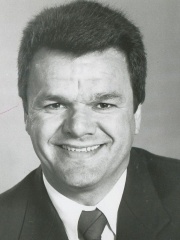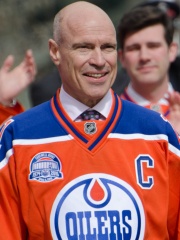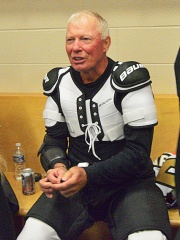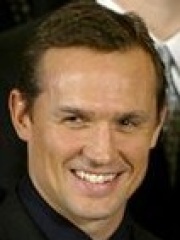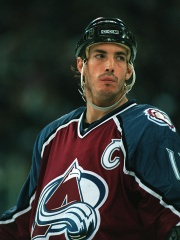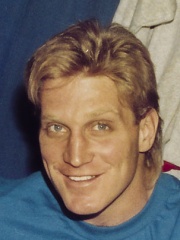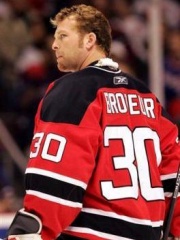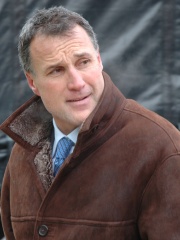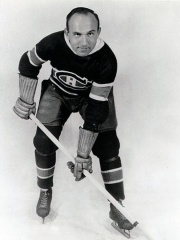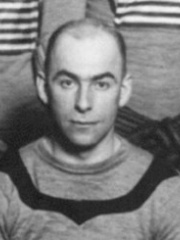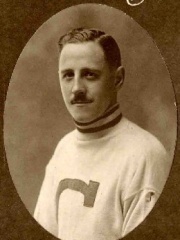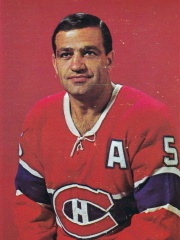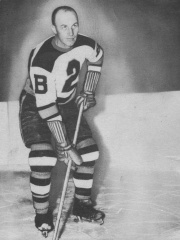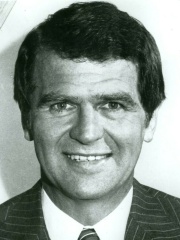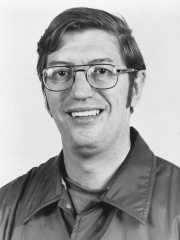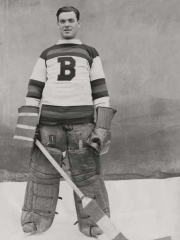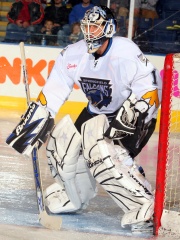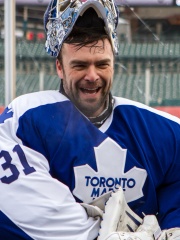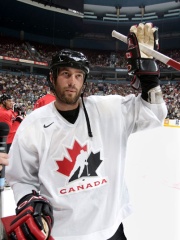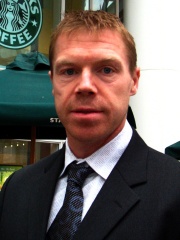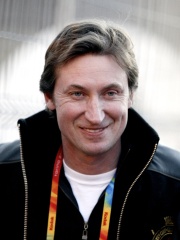
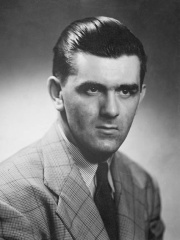
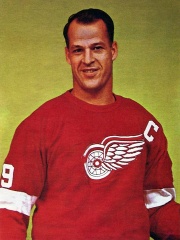
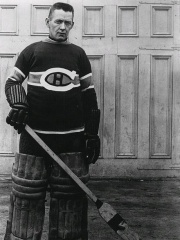
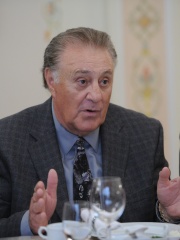
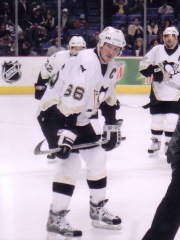
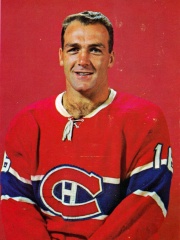
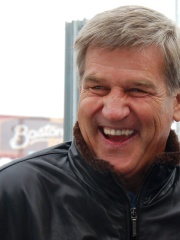
The Most Famous
HOCKEY PLAYERS from Canada
This page contains a list of the greatest Canadian Hockey Players. The pantheon dataset contains 676 Hockey Players, 108 of which were born in Canada. This makes Canada the birth place of the most number of Hockey Players.
Top 10
The following people are considered by Pantheon to be the top 10 most legendary Canadian Hockey Players of all time. This list of famous Canadian Hockey Players is sorted by HPI (Historical Popularity Index), a metric that aggregates information on a biography’s online popularity. Visit the rankings page to view the entire list of Canadian Hockey Players.

1. Wayne Gretzky (b. 1961)
With an HPI of 58.08, Wayne Gretzky is the most famous Canadian Hockey Player. His biography has been translated into 59 different languages on wikipedia.
Wayne Douglas Gretzky ( GRET-skee; born January 26, 1961) is a Canadian former professional ice hockey player and former head coach. He played 20 seasons in the National Hockey League (NHL) for four teams from 1979 to 1999, retiring at the age of 38. Nicknamed "the Great One", he has been called the greatest ice hockey player ever by many sportswriters, players, The Hockey News, and the NHL itself, based on extensive surveys of hockey writers, ex-players, general managers and coaches. Gretzky is the leading career goal scorer, assist producer and point scorer in NHL history, and has more career assists than any other player has total points. He is the only NHL player to total over 200 points in one season, a feat he accomplished four times. In addition, Gretzky tallied over 100 points in 15 professional seasons, 13 of them consecutively. At the time of his retirement in 1999, he held 61 NHL records: 40 regular season records, 15 playoff records, and 6 All-Star records. Born and raised in Brantford, Ontario, Gretzky honed his skills on a backyard rink and regularly played minor hockey at a level far above his peers. Despite his unimpressive size and strength, Gretzky's intelligence, stamina, and reading of the game were unrivaled. He was adept at dodging checks from opposing players, consistently anticipated where the puck was going to be, and executed the right move at the right time. Gretzky became known for setting up behind his opponent's net, an area that was nicknamed "Gretzky's office". Gretzky was the top scorer in the 1978 World Junior Championships. In June 1978, he signed with the Indianapolis Racers of the World Hockey Association (WHA), where he briefly played before being traded to the Edmonton Oilers. When the WHA folded, the Oilers joined the NHL, where he established many scoring records and led his team to four Stanley Cup championships. Gretzky's trade to the Los Angeles Kings on August 9, 1988, had an immediate impact on that team's performance, ultimately leading them to the 1993 Stanley Cup Finals, and he is credited with popularizing hockey in California. Gretzky played briefly for the St. Louis Blues before finishing his career with the New York Rangers. Gretzky captured nine Hart Trophies as the most valuable player, 10 Art Ross Trophies for most points in a season, two Conn Smythe Trophies as playoff MVP and five Lester B. Pearson Awards (now called the Ted Lindsay Award) for most outstanding player as judged by his peers. He led the league in goal-scoring five times and assists 16 times. He also won the Lady Byng Memorial Trophy for sportsmanship and performance five times and often spoke out against fighting in hockey. After his retirement in 1999, Gretzky was immediately inducted into the Hockey Hall of Fame, making him the most recent player to have the waiting period waived. The NHL retired his jersey number 99 league-wide. Gretzky was one of six players voted to the International Ice Hockey Federation's (IIHF) Centennial All-Star Team. He was inducted into the IIHF Hall of Fame in 2000, and received the Order of Hockey in Canada in 2012. Gretzky became executive director for the Canadian national men's hockey team during the 2002 Winter Olympics, in which the team won a gold medal. In 2000, he became part-owner of the Phoenix Coyotes, and following the 2004–05 NHL lock-out, he became the team's head coach. In 2004, Gretzky was inducted into the Ontario Sports Hall of Fame. In September 2009, following the Phoenix Coyotes' bankruptcy, Gretzky resigned as head coach and relinquished his ownership share. In October 2016, he returned to the Oilers as a minority partner and vice-chairman of their parent company, Oilers Entertainment Group. He left in 2021 to become an analyst on Turner Sports' NHL coverage.

2. Maurice Richard (1921 - 2000)
With an HPI of 57.38, Maurice Richard is the 2nd most famous Canadian Hockey Player. His biography has been translated into 34 different languages.
Joseph Henri Maurice "Rocket" Richard (; French: [ʁiʃaʁ]; August 4, 1921 – May 27, 2000) was a Canadian professional ice hockey player who played 18 seasons in the National Hockey League (NHL) for the Montreal Canadiens. He was the first player in NHL history to score 50 goals in one season, accomplishing the feat in 50 games in 1944–45, and the first to reach 500 career goals. Richard retired in 1960 as the National Hockey League's all-time leader in goals with 544. He won the Hart Trophy as the NHL's most valuable player in 1947, played in 13 All-Star Games and was named to 14 post-season NHL All-Star teams, eight on the first team. In 2017, Richard was named one of the 100 Greatest NHL Players in history. His younger brother Henri also played his entire career with the Canadiens, the two as teammates for Maurice's last five years. A centre nicknamed the "Pocket Rocket", Henri is enshrined alongside Maurice in the Hockey Hall of Fame. Richard, Elmer Lach and Toe Blake formed the "Punch line", a high-scoring forward line of the 1940s. Richard was a member of eight Stanley Cup championship teams, including a league record five straight between 1956 and 1960; he was the team's captain for the last four. The Hall of Fame waived its five-year waiting period for eligibility and inducted Richard in 1961. In 1975 he was inducted into Canada's Sports Hall of Fame. The Canadiens retired his number, 9, in 1960, and in 1999 donated the Maurice "Rocket" Richard Trophy to the NHL, awarded annually to the league's regular season leading goal-scorer. The oldest of eight children, Richard emerged from a poverty-stricken family during the Great Depression and was initially viewed as a fragile player. A string of injuries prevented him from joining the Canadian military during the Second World War. Intense, he was renowned for his physical and occasionally violent style of play. Richard was involved in a vicious on-ice incident late in the 1954–55 season during which he struck a linesman. NHL President Clarence Campbell suspended him for the remainder of the season and playoffs, which precipitated the Richard Riot in Montreal. The riot has taken on a mythical quality in the decades since and is often viewed as a precursor to Quebec's Quiet Revolution. Richard was a cultural icon among Quebec's francophone population; his legend is a primary motif in Roch Carrier's short story The Hockey Sweater, an emblematic work of Canadian culture. In 1998, Richard was diagnosed with abdominal cancer and died from the disease two years later. He was the first non-politician to be honoured by the province of Quebec with a state funeral. Joseph Henri Maurice Richard was born August 4, 1921, in Montreal, Quebec. His father, Onésime Richard, was originally from the Gaspé region of Quebec, before moving to Montreal, where he married Maurice's mother, Alice Laramée. The couple settled in the neighbourhood of Nouveau-Bordeaux. Maurice was the oldest of eight children; he had three sisters: Georgette, Rollande and Marguerite; and four brothers: René, Jacques, Henri and Claude. Onésime was a carpenter by trade, and took a job with the Canadian Pacific Railway shortly after Maurice was born. The Richards struggled during the Great Depression; Onésime lost his job in 1930 and the family relied on government aid until he was re-hired by the railway around 1936. Richard received his first pair of ice skates when he was four, and grew up skating on local rivers and a small backyard ice surface his father created. He did not play organized hockey until he was 14. Instead, Richard developed his skills playing shinny and "hog" – a game that required the puck carrier to keep the puck away from others for as long as possible. While he also played baseball and was a boxer, hockey was his passion. After he began playing in organized leagues, Richard joined several teams and used pseudonyms such as "Maurice Rochon" to circumvent rules that restricted players to one team. In one league, he led his team to three consecutive championships and scored 133 of his team's 144 goals in the 1938–39 season. At 16, Richard dropped out of school to work with his father as a machinist. He enrolled in a technical school, intent on earning a trade certificate. At 18, Richard joined the Verdun Juniors, though as a rookie he saw little ice time in the regular season. He scored four goals in ten regular season games, and added six goals in four playoff games as Verdun won the provincial championship. He was promoted to the Montreal Canadiens' affiliate in the Quebec Senior Hockey League in 1940, but suffered a broken ankle in his first game after crashing into the boards and missed the remainder of the season. The injury also aborted his hopes of joining the Canadian military: he was called to a recruitment centre in mid-1941, but was deemed unfit for combat. Off the ice, Richard was a quiet, unassuming youth who spoke little. He met his future wife Lucille Norchet when he was seventeen, and she was thirteen. She was the younger sister of one of his teammates at Bordeaux, and her bright, outgoing personality complemented Richard's reserved nature. Lucille proved adept at guiding him through trials and disappointments he experienced in both hockey and life. They were engaged when he was 20, and though her parents felt she was too young, married on September 12, 1942, when she was seventeen. Having recovered from his broken ankle in time for the 1941–42 season, Richard returned to the QSHL Canadiens, with whom he played 31 games and recorded 17 points before he was again injured. He suffered a broken wrist after becoming entangled with a defenceman and crashed into the net. Richard rejoined the team for the playoffs. The skills he demonstrated in the QSHL, combined with the NHL parent club's loss of players to the war and struggles to draw fans due to its poor record and a lack of francophone players, earned Richard a tryout with the Canadiens for the 1942–43 season. He signed a contract worth $3,500 for the year and, wearing sweater number 15, made his NHL debut with the team. Richard's first goal was against the New York Rangers on November 8, 1942. Injury again sidelined Richard as his rookie season ended after only 16 games when he suffered a broken leg. The string of broken bones so early in his career left observers wondering if Richard was too fragile to play at the highest levels. He made a second attempt to enlist with the military but was again turned down after x-rays revealed that his bones had not healed properly; Richard's ankle was left permanently deformed, forcing him to alter his skating style. Humiliated by the rejection, he intensified his training and reported to Montreal's training camp for the 1943–44 season fully healthy. The arrival of his daughter Huguette prompted Richard to change his uniform to number 9 to match her birth weight of nine pounds. Remaining healthy throughout the season, Richard appeared in 46 of Montreal's 50 games. He led the Canadiens with 32 goals and tallied 54 points, third-best in his team. His first full NHL season not only ended the criticism about his ability to play in the league, but established him as one of the best young players in the league. Coach Dick Irvin shifted him from left wing to right and put him on a forward line with Toe Blake and Elmer Lach. The trio, known as the "Punch line", formed a dominant scoring unit throughout the 1940s. The Canadiens lost only six games after October, and went on to win the franchise's first Stanley Cup championship in 13 years. Richard led the league with 12 playoff goals, including a five-goal effort against the Toronto Maple Leafs in a semi-final game. He tied Newsy Lalonde's NHL record for goals in one playoff game (equalled by three players since), which resulted in his being named first, second and third star of the game, as chosen by journalist Charles Mayer. Richard was named a second team All-Star following the season. It was the first of 14 consecutive years he was named a league all-star. The 1944–45 NHL season was a record-setting one for Richard. He first set a new mark for points in one game when he made five goals and three assists in a 9–1 victory over the Detroit Red Wings on December 28, 1944; his eight points broke the previous record of seven held by three players, and stood for 32 years until surpassed in 1976 by Darryl Sittler. Richard achieved the feat despite arriving for the game exhausted from moving into his new home that afternoon. He continued scoring at an unprecedented rate, and by February 1945 was approaching Joe Malone's 27-year-old NHL record, set in 1918, of 44 goals in one season. Richard broke the record on February 25, 1945, in a 5–2 victory over Toronto. Malone was on hand to present Richard with the puck used to score the 45th goal. As Richard approached 50 goals for the season, opposition players resorted to increasingly violent efforts to prevent him from scoring. He had to fight past slashes, hooks, and even players who draped themselves across his back. Richard went eight games without scoring and began Montreal's final regular season game, March 18, on the road against the Boston Bruins with 49 goals. He finally reached the milestone by scoring with 2:15 remaining in the game, a 4–2 Montreal win. He became the first player to score 50 goals, a record that would stand until the 1960–61 season, when fellow Canadien, Bernie "Boom Boom" Geoffrion scored 50 goals in 64 regular season games Archived October 26, 2021, at the Wayback Machine. Richard's mark was not surpassed until Bobby Hull scored 54 goals in 65 games while playing for the Chicago Blackhawks during the 1965–66 season. His mark of 50 goals in 50 games also became a standard that remains one of the most celebrated achievements in NHL history, unmatched until 36 years later when Mike Bossy did it in 1981 – the first of only four players to match Richard's 50-in-50, in the more than 70 years since Richard set the mark. Richard finished the season with 73 points, seven behind Lach and six ahead of Blake, as the Punch line finished first, second and third in league scoring. Richard finished second in the voting for the Hart Trophy as the league's most valuable player, behind Lach. Richard's critics argued that his scoring record was the result of talent dilution brought about by the war; when many players returned in 1945–46, he won his second Stanley Cup with Montreal, but his goal output was nearly halved to 27. Richard again reached lofty scoring totals in 1946–47, leading the league with 45 goals in a 60-game season and winning the Hart Trophy as the league's most valuable player for the only time of his career. He finished second or third in the Hart Trophy voting a further five times in his career. Opponents continued their attempts to drive Richard to anger or frustration, as they had learned he could be goaded into taking himself out of the game by violently retaliating and fighting. One such incident occurred in the 1947 Stanley Cup Finals when Richard received a match penalty for striking Toronto's Bill Ezinicki over the head with his stick in a game two loss. Richard was suspended for the third game of the series, which the Maple Leafs won. As the reigning most valuable player, Richard sought a pay raise prior to the 1947–48 season. General manager Frank Selke refused, even after Richard and team captain Émile Bouchard both sat out the Canadiens' preseason before capitulating and returning to the team when the season began. The Punch line was broken up after Blake suffered a career-ending leg injury. Richard's season also ended early as he missed the final games of the season due to a knee injury. He finished second in team scoring with 53 points in 53 games, but Montreal missed the playoffs. After recording only 38 points in 1948–49, Richard posted a 65-point campaign the next season and his 43 goals led the NHL for the third time. In 1950–51, Richard scored 42 goals, including his 271st career goal, making him Montreal's all-time goal leader. Richard missed over 20 games of the 1951–52 season due to injury, but overcame another ailment in the playoffs. In the seventh and deciding game of the semi-final against Boston, Richard was checked by Leo Labine and briefly knocked unconscious after he fell and struck his head on Bill Quackenbush's knee. Though dazed, Richard returned to the game late in the third period after a large cut above his eye was stitched up. Canadiens coach Dick Irvin sent Richard back onto the ice in the final minutes of the contest, despite knowing Richard had suffered a concussion. Richard scored the winning goal in a 2–1 victory that sent Montreal to the 1952 Stanley Cup Finals. Following the game, a bloodied and still disoriented Richard was photographed shaking the hand of Boston goaltender Jim Henry, who was also showing symptoms of injuries from the series and who appeared to be bowing to Richard following the Montreal player's "unconscious goal". The photograph by Roger St. Jean is among the most famous images of Richard. In the final, Montreal lost to Detroit in four straight games. The 1952–53 season began with Richard in close pursuit of Nels Stewart's all-time NHL record of 324 goals. Richard tied the record in Toronto on October 29, 1952, by scoring two goals against the Maple Leafs; his achievement earned a rousing ovation from Montreal's rival fans. He failed to score in his following three games as frenzied fans followed each contest in anticipation of the record-breaking marker. In his fourth try, a November 8 game against Chicago, Richard scored his 325th goal at the 10:01 mark of the second period. According to the Montreal Gazette, the ovation Richard received from his fans "shook the rafters" of the Montreal Forum. He finished the season with team-leading totals of 61 points and 28 goals – becoming the first player in NHL history to score at least 20 goals in his first ten full seasons. Aided by Richard's 7 goals in 12 playoff games, the Canadiens defeated Boston in the 1953 Stanley Cup Finals to capture Montreal's first Stanley Cup championship since 1946. Richard led the league in goals for the fourth time in his career with 37 in 1953–54, then for a fifth time in 1954–55 with 38 (shared with Bernie Geoffrion). He scored his 400th career goal on December 18, 1954, against Chicago. Opposition players continued to try to stop Richard through physical intimidation, and he often retaliated with equal force. The situation led to a running feud with NHL President Clarence Campbell. Richard had been fined numerous times by Campbell for on-ice incidents and at one point was forced to post a $1,000 "good-behaviour bond" after he criticized Campbell in a weekly column he helped author for Samedi-Dimanche. Richard was among many in Quebec who believed that Campbell treated French Canadian players more harshly than their English counterparts. The simmering dispute erupted after an incident in the Canadiens' March 13, 1955, game against Boston, when Hal Laycoe struck Richard in the head with his stick. Richard retaliated by slashing viciously at Laycoe's head, then punched linesman Cliff Thompson when the official attempted to intervene. Boston police attempted to arrest Richard for assault following the incident, but Montreal coaching staff and teammates refused police entry in protest. Following two days of deliberation, Campbell announced that he had suspended Richard – who was leading the NHL's overall scoring race at the time – for the remainder of the regular season and the playoffs. In English Canada, Campbell was praised for doing what he could to control the erratic Richard. Unknown to most at the time, Campbell had long wanted to impose a lengthy suspension on Richard over his previous outbursts. As NHL president however, Campbell ultimately answered to the league's owners and they were reluctant to see such severe discipline imposed against one of the league's star players on account of their value in increasing game attendance. In French Quebec the suspension was viewed as an injustice, an unfair punishment given to a Francophone hero by the Anglophone establishment. Richard's supporters reacted angrily to Campbell: he received several death threats and, upon taking his customary seat at the next Canadiens game, unruly fans pelted him with vegetables, eggs and other debris. One fan threw a tear gas bomb at Campbell, which resulted in the Forum's evacuation and the game's forfeiture in Detroit's favour. Fans fleeing the arena were met by a large group of demonstrators who had massed outside prior to the game's start. The mob of over 20,000 people developed into a riot. Windows and doors were smashed at the Forum and surrounding businesses. By the following morning, between 65 and 70 had been arrested. Over 50 stores were looted and 37 people injured. Damage was estimated at $100,000 ($1,114,184 in 2023 dollars). Richard had also attended the game, but left immediately following the forfeit. Frank Selke attempted to persuade him to return to try to disperse the crowd, but Richard refused, fearing that he would instead further inflame the passions of the mob. He took to the radio the next day asking for calm: "Do no more harm. Get behind the team in the playoffs. I will take my punishment and come back next year and help the club and the younger players to win the Cup." The suspension cost Richard the Art Ross Trophy as the leading point scorer in the league, which he lost to teammate Geoffrion by one point. Richard never won the point title, finishing second five times in his career. Montreal fans booed Geoffrion when he surpassed Richard on the final day of the regular season. The fans continued to jeer Geoffrion into the following season. Montreal reached and lost the 1955 Stanley Cup Finals four games to three without Richard. The defeat was a bitter loss for Richard, who struggled to control his anger. Richard fulfilled his promise to Canadiens' fans, made in his post-riot radio address, by leading Montreal to a Stanley Cup championship in 1955–56 – the start of a still unprecedented 5 consecutive Stanley Cup victories by one team. The season began with the arrival of his young brother and future fellow NHL Hall of Famer Henri, a centre given the nickname the "Pocket Rocket" to the Canadiens roster. It also marked the return of his former Punch line teammate, Toe Blake, as head coach. Along with general manager Frank Selke, Blake worked with Richard on moderating his temper and responding to the provocation of his opponents by scoring goals rather than engaging in fisticuffs. Richard finished the season with 38 goals and 71 points, second on the team in both respects to Jean Béliveau's 47 goals and 88 points. Richard added 14 points in 10 playoff games as Montreal defeated Detroit to claim the Stanley Cup. He scored the second and ultimately Cup-clinching goal in the fifth and final game, a 3–1 victory. Entering his 15th NHL season in 1956–57, Richard's teammates named him captain of the Canadiens, succeeding Émile Bouchard, who had retired prior to the season. With 33 goals and 62 points, Richard again finished second on the team to Béliveau. In the playoffs, he scored the overtime-winning goal in the fifth game of the semi-final to eliminate New York, then scored four goals in a 5–1 victory over Boston in the first game of the finals en route to a five-game series win and second consecutive championship for Montreal. Richard reached a major scoring milestone early in the 1957–58 season. During the first period of a 3–1 victory over Chicago on October 19, 1957, he became the first player in NHL history to score 500 goals in his career. As Richard celebrated with his teammates, it was announced to the Montreal Forum crowd: "Canadiens' goal, scored by Mr. Hockey himself, Maurice Richard". He played only 28 regular season games that season, scoring 34 points, as he missed three months due to a severed Achilles tendon. Returning in time for the playoffs, Richard led Montreal with 11 goals and 15 points as the team won its third consecutive Stanley Cup. He scored the overtime-winning goal in the fifth game of the finals against Boston. It was the sixth playoff overtime-winning goal of his career, and the third during the finals, both NHL records. At 37, Richard was the oldest player in the NHL in 1958–59. He scored 38 points in 42 games, but missed six weeks due to a broken ankle. Injuries again plagued Richard during the 1959–60 season as he missed a month due to a broken cheekbone. Montreal nonetheless won the Stanley Cup in both seasons. Richard scored no points in four games in the 1959 Stanley Cup Finals, but recorded a goal and three assists in 1960. The titles were the seventh and eighth of Richard's career, and Montreal's five consecutive championships remain a record. The 1956–60 Canadiens rank as one of eight dynasties recognized by the NHL. The playoff goal was Richard's last, as on September 15, 1960, he announced his retirement as a player. Richard had reported to Montreal's training camp that autumn, but Selke compelled Richard to end his playing career, fearing he was risking serious injury. In Richard's retirement speech, he said he had been contemplating leaving the game for two years, and stated that at age 39, the game had become too fast for him. Upon learning of Richard's retirement, Gordie Howe offered praise for his former rival: "He sure was a drawing card. He brought in the crowds that helped pay our wages. Richard certainly has been one of the greatest players in the game and we will miss him." Richard was nicknamed "the Comet" early in his career. When teammate Ray Getliffe remarked that Richard "went in like a rocket" as he approached the opposition goal, Richard was dubbed "The Rocket" by a local sportswriter; both Baz O'Meara from the Montreal Star and Dink Carroll of the Montreal Gazette have been credited for the appellation. The nickname described Richard's play in terms of speed, strength, and determination. Teammate and coach Toe Blake said the moniker was fitting because "when he would take off, nothing got in his way that could stop him". Goaltender Jacques Plante declared it one of the most appropriate nicknames given to an athlete, noting the fierce intensity that often showed in Richard's eyes and comparing it to "the rocket's red glare" referenced in "The Star-Spangled Banner". Glenn Hall agreed: "What I remember most about Rocket was his eyes. When he came flying toward you with the puck on his stick, his eyes were all lit up, flashing and gleaming like a pinball machine. It was terrifying." The prime of Richard's career was the era immediately following the Second World War, where battle-hardened players returned to the NHL and implemented a "gladiatorial" style that featured rugged, physical and often violent play. Richard's own temper was infamous, as illustrated by his actions that precipitated the Richard Riot. A pure goal-scorer, Richard did not play with finesse, nor was he known for his passing. One of his teammates remarked that "Maurice wouldn't even pass you the salt". Richard led the NHL in goals five times, but never in points. He was best known for dashing toward the net from the blue line and was equally adept at scoring from his forehand or backhand. His exploits revived a Montreal Canadiens franchise that had struggled to draw fans in the 1930s. In addition to his 14 appearances on post-season all-star teams (eight on the first team, six on the second), Richard played in 13 consecutive NHL All-Star Games between 1947 and 1959. Richard was still an active player when Gordie Howe overtook his career record for points. Howe surpassed Richard's career mark of 544 goals in 1963, while the latter's record of 50 goals in one season stood for 20 years until broken by Bobby Hull in 1965. The Montreal Canadiens donated the Maurice "Rocket" Richard Trophy to the NHL in 1999 as an award presented annually to the league's leading goal scorer. Upon his retirement as a player, Selke offered Richard a job as a team ambassador and promised to pay him his full playing salary in the first year. After serving in the position for three years, Richard was named a vice-president of the Canadiens in 1964. He became disgruntled with a role he felt was powerless and only honorary, and resigned one year later. Richard grew estranged from the organization as his desire to be involved in the team's operations was ignored, and the split deepened when the Canadiens forced Frank Selke to retire in 1965. He eventually refused to allow his name to be associated with the team. As Richard struggled both with the need to find a purpose to his post-retirement life and the fear of being forgotten, he attached his name to numerous endeavours. He acted as a consulting editor for a magazine titled Maurice Richard's Hockey Illustrated, owned the "544 / 9 Tavern" (named for his career goal total and sweater number) in Montreal, and was a pitchman for dozens of products, including beer, hair dye, car batteries, fishing tackle and children's toys. He continued to use his name as a promotional vehicle for over 30 years after his retirement. Richard briefly returned to hockey in 1972 as head coach for the Quebec Nordiques of the World Hockey Association. He lasted only two games, a win and a loss, before finding himself unable to handle the strain of coaching. Richard reconciled with the Canadiens in 1981 and resumed his team ambassador role. Richard and his wife, Lucille, lived in Montreal where they raised seven children: Huguette, Maurice Jr., Norman, André, Suzanne, Paulo and Jean. They had 14 grandchildren. Lucille died of cancer in 1994, two years after the Richards celebrated their 50th wedding anniversary. Richard's companion late in his life was Sonia Raymond. It was announced in 1998 that Richard was diagnosed with abdominal cancer. He died from the disease two years later on May 27, 2000 and was entombed at the Notre Dame des Neiges Cemetery in Montreal. Prior to game 1 of the 2000 Stanley Cup Finals between the New Jersey Devils and Dallas Stars, there was a short tribute video highlighting the great moments and legacy of Richard's career. Numerous honours were bestowed upon Richard throughout and following his career: the Canadian Press named him its male athlete of the year on three occasions, and in 1957, Richard won the Lou Marsh Trophy as Canada's athlete of the year. The Canadiens retired his sweater number 9 in 1960, while the Hockey Hall of Fame waived its five-year waiting period after retirement and inducted him in 1961. That same year, the 5,000-seat Maurice Richard Arena was built and named in his honour. Upon the creation of the Order of Canada in 1967, Richard was named one of the inaugural members and, in 1998, was elevated to the rank of Companion of the Order of Canada. Canada's Sports Hall of Fame honoured him in 1975, and Richard was given a star on Canada's Walk of Fame in 1999. He was appointed to the Queen's Privy Council for Canada in 1992. While he was a popular player throughout Canada, Richard was an icon within Quebec. Author Roch Carrier explained the passion Richard elicited from the fans in his 1979 Canadian-classic short story The Hockey Sweater. Carrier wrote of how he and his friends all emulated Richard's style and mannerisms: "we were five Maurice Richards against five other Maurice Richards, throwing themselves on the puck. We were ten players all wearing the uniform of the Montreal Canadiens, all with the same burning enthusiasm. We all wore the famous number 9 on our backs." The story's publication, and subsequent adaptation into a National Film Board animated short helped entrench Richard's image as a pan-Canadian icon. Richard's popularity persisted late into his life: when introduced as part of the ceremonies following the final hockey game at the Montreal Forum, Richard was brought to tears by Canadiens' fans, who acknowledged him with an 11-minute standing ovation. Upon his death, the province of Quebec honoured Richard with a state funeral, a first in Quebec for a non-politician. Over 115,000 people paid their respects by viewing his lying in state at the Molson Centre. The Richard Riot has achieved a mythical place in Canadian folklore. The riot is commonly viewed as a violent manifestation of the discontent Francophones within Quebec held with their place in largely Anglophone Canada, and some historians consider the riot to be a precursor to the 1960s Quiet Revolution. In its 40th anniversary retrospective of the Riot, Montreal newspaper La Presse opened with the following passage: "Forty years ago began one of the most dramatic episodes in the history of Quebec, and of hockey." Richard himself publicly dismissed his role as a catalyst for cultural or political change. In a 1975 interview, he said he played with "English boys" and was largely unaware of the situation in French Quebec at the time. In an article published four days after the riot, journalist André Laurendeau was the first to suggest that it was a sign of growing nationalism in Quebec. Laurendeau suggested the riot "betrayed what lay behind the apparent indifference and long-held passiveness of French Canadians". In contrast, in his book The Rocket: A Cultural History of Maurice Richard, Benoît Melançon disputes the importance of the riot, stating its perceived importance in history grew retroactively with Richard's myth. Melançon wrote: "According to this popular narrative, for the first time the people of Quebec stood up for themselves; especially English Canada delights in anachronistically announcing that this was the beginning of the 1960s Quiet Revolution." Richard is the subject of the 2005 biopic The Rocket. List of family relations in the NHL List of players with five or more goals in an NHL game There is a Maurice Richard fonds at Library and Archives Canada. The archival reference number is R9534. Biographical information and career statistics from NHL.com, or Eliteprospects.com, or Hockey-Reference.com, or Legends of Hockey, or The Internet Hockey Database "Rocket" Richard: The Legend – The Legacy – Canadian Museum of History "Maurice Richard". Dictionary of Canadian Biography (online ed.). University of Toronto Press. 1979–2016.

3. Gordie Howe (1928 - 2016)
With an HPI of 55.50, Gordie Howe is the 3rd most famous Canadian Hockey Player. His biography has been translated into 40 different languages.
Gordon Howe (March 31, 1928 – June 10, 2016) was a Canadian professional ice hockey player. From 1946 to 1980, he played 26 seasons in the National Hockey League (NHL) and six seasons in the World Hockey Association (WHA); his first 25 seasons were spent with the Detroit Red Wings. Nicknamed "Mr. Hockey", Howe is often considered the most complete player to ever play the game and one of the greatest of all time. At his retirement, his 801 goals, 1,049 assists, and 1,850 total points were all NHL records that stood until they were broken by Wayne Gretzky, who himself has been a major champion of Howe's legacy. A 23-time NHL All-Star, he shares the NHL record for seasons played with Chris Chelios, and his all-time NHL games played record of 1,767 was only surpassed in 2021 by Patrick Marleau. In 2017, Howe was named one of the "100 Greatest NHL Players". Howe made his NHL debut with the Red Wings in 1946. He won the Art Ross Trophy for leading the league in points each year from 1950–51 to 1953–54, then again in 1956–57 and 1962–63, for a total of six times, which is the second most in NHL history. He led the NHL in goal scoring four times. He ranked among the top ten in NHL scoring for 21 consecutive years and set an NHL record for points in a season (95) in 1953, a record which was broken six years later. He won the Stanley Cup with the Red Wings four times and won six Hart Trophies as the NHL's most valuable player. He also led the NHL in playoff points six times. Howe retired for the first time in 1971 and was immediately inducted into the Saskatchewan Sports Hall of Fame that same year. He was then inducted into the Hockey Hall of Fame the next year, but came back two years later to join his sons Mark and Marty on the Houston Aeros of the WHA. Although in his mid-40s, he scored over 100 points twice in six years, won two straight Avco World Trophies (1974 and 1975) and was named most valuable player in 1974. He made a brief return to the NHL in 1979–80, playing one season with the Hartford Whalers, then retired at age 52. His involvement with the WHA was central to their brief pre-NHL merger success, forcing the NHL to recruit European talent and expand to new markets. Howe was most famous for his scoring prowess, physical strength and career longevity, and redefined the ideal qualities of a forward. He is the only player to have competed in the NHL in five different decades (1940s through 1980s); he also played a shift in a 1997 game for the Detroit Vipers of the IHL, playing professional hockey for a sixth decade. He became the namesake of the "Gordie Howe hat trick": a goal, an assist, and a fight in the same game, though he only recorded two such games in his career. He was the inaugural recipient of the NHL Lifetime Achievement Award in 2008.

4. Georges Vézina (1887 - 1926)
With an HPI of 52.73, Georges Vézina is the 4th most famous Canadian Hockey Player. His biography has been translated into 19 different languages.
Joseph Georges Gonzague Vézina (; French: [ʒɔʁʒ vezina]; January 21, 1887 – March 27, 1926) was a Canadian professional ice hockey goaltender who played seven seasons in the National Hockey Association (NHA) and nine in the National Hockey League (NHL), all with the Montreal Canadiens. After being signed by the Canadiens in 1910, Vézina played in 327 consecutive regular season games and a further 39 playoff games, before leaving early during a game in 1925 due to illness. Vézina was diagnosed with tuberculosis, and died on March 27, 1926. The only goaltender to play for the Canadiens between 1910 and 1925, Vézina helped the team win the Stanley Cup in 1916 and 1924, while reaching the Stanley Cup Finals three more times. Nicknamed the "Chicoutimi Cucumber" for his calm composure while in goal, Vézina allowed the fewest goals in the league seven times in his career: four times in the NHA and three times in the NHL. In 1918, Vézina became the first NHL goaltender to both record a shutout and earn an assist on a goal. At the start of the 1926–27 NHL season, the Canadiens donated the Vezina Trophy to the NHL as an award to the goaltender who allowed the fewest goals during the season. Since 1981, the award has been given to the most outstanding goaltender as determined by a vote of NHL general managers. In Vézina's hometown of Chicoutimi, the sports arena is named the Centre Georges-Vézina in his honour. When the Hockey Hall of Fame opened in 1945, Vézina was one of the original nine inductees, and in 2017 the NHL included him on their list of the 100 greatest players in league history. Georges, the fifth of eight children, was born on January 21, 1887, in Chicoutimi, Quebec, to Georges-Henri Vézina, a local baker and his wife Clara Belley. Georges attended school at the Petit Séminaire de Chicoutimi from 1898 until the age of fourteen, when he left the school to help at his father's bakery. He played hockey from a young age, participating in informal street hockey matches with others his own age. Vézina partook in these matches in his shoes, and used skates for the first time at age 16 when he joined the local team in Chicoutimi. As Chicoutimi was in a remote area of Quebec, more than 200 kilometres from Quebec City, the hockey club was not in any organised league. Rather the club, known as the Saguenéens ("People from the Saguenay", the region where Chicoutimi is located), toured the province, playing exhibition games against a variety of clubs. Vézina married Marie-Adélaïde-Stella Morin on June 3, 1908, in Chicoutimi. After Vézina's death, it was reported that he had fathered 22 children. This rumour was started when the Canadiens' manager, Léo Dandurand, told reporters that Vézina "speaks no English and has twenty-two children, including three sets of triplets, and they were all born in the space of nine years." In actuality the Vézinas only had two children and Georges spoke broken English. In 1912 they had their first child, a son named Jean-Jules. A second son was born the night of the Montreal Canadiens' first Stanley Cup win in 1916. To honour the event, Georges named the child Marcel Stanley. When not playing hockey, Vézina operated a tannery in Chicoutimi, living a quiet life. On February 17, 1910, the Chicoutimi Hockey Club played an exhibition match against the Montreal Canadiens. Though playing an inferior team the Canadiens failed to score a goal, losing the game. This prompted Joseph Cattarinich, goaltender for the Canadiens, to convince his team to offer a tryout to Georges Vézina, who was Chicoutimi's goaltender. Vézina initially refused the offer, staying in Chicoutimi until the Canadiens returned in December of that year. This time they convinced Georges, along with his brother Pierre, to come to Montreal. The two Vézina brothers arrived on December 22, 1910. While Pierre failed to make the team, Georges impressed the Canadiens, especially with the use of his stick to block shots. Vézina was signed to a contract for C$800 per season, and made his professional debut December 31, 1910, against the Ottawa Senators. He would play all 16 games for the Canadiens in the 1910–11 season, finishing with a record of eight wins and eight losses, while allowing the fewest goals in the league. The following season Vézina again led the league in goals against, as well as winning eight games, along with 10 losses. Vézina recorded his first career shutout during the 1912–13 season, defeating Ottawa 6–0 on January 18, 1913, for one of his nine wins in the season. The Canadiens finished first in the NHA for the first time in 1913–14, in a tie with the Toronto Blueshirts. Once again, Vézina led the league with the fewest goals against, while posting 13 victories and seven losses. Under the NHA rules, the first place team would play in the Stanley Cup Finals, but due to the tie for first, the Canadiens had to play a two-game, total-goals series against Toronto. Vézina shut out the Blueshirts in the first game, a 2–0 win for Montreal, but let in six goals in the second game, allowing the Blueshirts to play for the Stanley Cup, which they won. After losing 14 games and finishing last in the NHA in 1914–15, Vézina and the Canadiens won 16 games during the 1915–16 season, placing the team first in the league. As league leaders, the Canadiens earned the right to play in the 1916 Stanley Cup Finals, where they faced off against the Portland Rosebuds, champions of the rival Pacific Coast Hockey Association. The Canadiens defeated the Rosebuds three games to two in the best-of-five-games series, winning the Stanley Cup for the first time in team history. Vézina's second son was born the night of the fifth game, which coupled with a bonus of $238 each member of the Canadiens received for the championship, led to him considering the series as the pinnacle of his career. The following season Vézina again led the NHA with the fewest goals against, the fourth time in seven years he did so, helping the Canadiens to again reach the Stanley Cup Finals, where they lost to the Seattle Metropolitans. The NHA gave way to the National Hockey League (NHL) in November 1917, with Vézina and the Canadiens joining the new league. On February 18, 1918, he became the first goaltender in NHL history to record a shutout, by blanking the Torontos 9–0. He finished the season with 12 wins, allowing the fewest goals against. Vézina also set a record, which was shared with Clint Benedict of the Ottawa Senators, for the fewest shutouts needed to lead the league, with one. During the 1918–19 Vézina became the first goaltender to be credited with an assist: during a December 28, 1918 game against Toronto Vézina made a save and gave the puck to Newsy Lalonde, who immediately scored. Vézina won 10 games during the season and helped the Canadiens defeat the Ottawa Senators in the NHL playoffs for the right to play for the Stanley Cup against the PCHA champion, the Seattle Metropolitans. Held in Seattle, the two teams were tied in the best-of-five series when it was cancelled due to the Spanish flu epidemic, the first time the Stanley Cup was not awarded. In the 10 playoff games prior to the cancellation, Vézina had won six games, lost three and tied one, with one shutout. Vézina recorded nearly identical records the next two seasons, with 13 wins, 11 losses and a goals against average above four in both 1919–20 and 1920–21. He won 12 games the following season, as the Canadiens again failed to qualify for the Stanley Cup. After winning 13 games in 1922–23, Vézina led the Canadiens into the NHL playoffs, where they lost the two-game, total-goal series to the Senators, who would win the Stanley Cup. The following season saw Vézina return to leading the league in fewest goals against. His average of 1.97 goals per game was the first time a goaltender had averaged fewer than two goals against per game. With another 13-win season in 1923–24, the Canadiens reached the NHL playoffs, where they again faced the Ottawa Senators. This time the Canadiens won the series, then defeated the Vancouver Maroons of the PCHA before reaching the Stanley Cup Finals for the first time in five years. Playing the Calgary Tigers of the Western Canada Hockey League, Vézina and the Canadiens won the best-of-three series two games to none, as Vézina recorded a shutout in the second game. The championship was the Canadiens' first as a member of the NHL and second title as a club. After a 17-win season in 1924–25 where Vézina recorded a goals-against average of 1.81 to again lead the league, the Canadiens reached the Stanley Cup Finals. The Canadiens only qualified after the Hamilton Tigers, the regular season champions, were suspended for refusing to play in the playoffs unless they were paid more. Facing the Victoria Cougars, the Canadiens lost the series three games to one. Returning to Montreal for training camp for the 1925–26 season, Vézina was noticeably ill, though he said nothing about it. By the time of the Canadiens' first game on November 28 against the Pittsburgh Pirates, he had lost 35 pounds in a span of six weeks, and had a fever of 102 Fahrenheit. Regardless, he took to the ice, and completed the first period without allowing a goal. Vézina began vomiting blood in the intermission before returning for the start of the second period. He then collapsed in his goal area, and left the game, with former U.S. Olympic team goaltender Alphonse Lacroix taking his place. Pittsburgh won the game, 1–0. The day after the game, Vézina was diagnosed with tuberculosis and advised to return home. He made a last trip into the Canadiens' dressing room on December 3 to say a final goodbye to his teammates. Dandurand would later describe Vézina as sitting in his corner of the dressing room with "tears rolling down his cheeks. He was looking at his old pads and skates that Eddie Dufour [the Canadiens trainer] had arranged in Georges' corner. Then, he asked one little favour—the sweater he had worn in the last world series." Vézina returned to his hometown of Chicoutimi with his wife Marie, where he died in the early hours on Saturday, March 27, 1926, at l'Hôtel-Dieu hospital. Though he played only one period for the Canadiens during the entire season, the team honoured his entire $6,000 salary, a testament to how important Vézina had been to the team. The Canadiens finished in last place in 1925–26. One of the dominant goaltenders in the NHA and early NHL, Vézina led the Canadiens to five Stanley Cup Finals appearances, where they won the title twice. Seven times in his career, Vézina had the lowest goals-against average in the league he played, and he had the second-best average another five times. From when he joined the Canadiens in 1910, until being forced to retire in 1925, Vézina never missed a game nor allowed a substitute, playing in 328 consecutive regular season games and an additional 39 playoff games. For the first several years of his career goaltenders could not leave their feet to make a save, and while this rule was changed in 1918 Vézina continued to play in this conservative style throughout his career. Even so, Vézina is regarded as one of the greatest goaltenders in the early days of hockey; the Montreal Standard referred to him as the "greatest goaltender of the last two decades" in their obituary. Well liked in Montreal, Vézina was often seen as the best player on the ice for the Canadiens, and was respected by his teammates, who considered him the spiritual leader of the team. Referred to as "le Concombre de Chicoutimi" (the "Chicoutimi Cucumber") for his cool demeanour on the ice, he was also known as "l'Habitant silencieux" (the "silent Habitant", Habitant being a nickname for the Canadiens), a reference to his reserved personality. He often sat in a corner of the team's dressing room alone, smoking a pipe and reading the newspaper. When news of Vézina's death was announced, newspapers across Quebec paid tribute to the goalie with articles about his life and career. Hundreds of Catholic masses were held in honour of the devout Vézina, and more than 1,500 people filled the Chicoutimi cathedral for his funeral. He was buried in le Cimetière Saint-Francois Xavier in Chicoutimi. A lasting legacy of Vézina was the trophy named after him. At the start of the 1926–27 season, Léo Dandurand, Leo Letourneau and Joseph Cattarinich, owners of the Montreal Canadiens, donated the Vezina Trophy to the NHL in honour of Vézina. The first trophy named after an NHL player, it was to be awarded to the goaltender of the team who allowed the fewest goals during the regular season. The inaugural winner of the trophy was Vézina's successor in goal for the Canadiens, George Hainsworth. He went on to win the trophy the next two seasons as well. In 1981, the NHL changed the format of awarding the trophy, instead giving it to the goaltender deemed best in the league based on a poll of NHL general managers. The Hockey Hall of Fame was established in 1945 and among the first nine inductees was Vézina. In 1998 Vézina was ranked number 75 on The Hockey News' list of the 100 Greatest Hockey Players. In honour of the first professional athlete to come from Chicoutimi, the city renamed their hockey arena the Centre Georges-Vézina in 1965. When the NHL announced its 100 greatest players in conjunction with the league's centennial 2017, Vézina was included on the list. Source: NHL.com History of the Montreal Canadiens List of ice hockey players who died during their playing career Biographical information and career statistics from NHL.com, or Eliteprospects.com, or Hockey-Reference.com, or Legends of Hockey, or The Internet Hockey Database
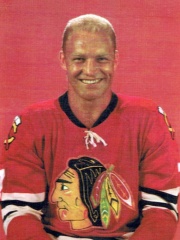
5. Bobby Hull (1939 - 2023)
With an HPI of 51.48, Bobby Hull is the 5th most famous Canadian Hockey Player. His biography has been translated into 32 different languages.
Robert Marvin Hull (January 3, 1939 – January 30, 2023) was a Canadian professional ice hockey player who is widely regarded as one of the greatest players of all time. His blond hair, skating speed, end-to-end rushes, and ability to shoot the puck at very high velocity all earned him the nickname "the Golden Jet". His talents were such that an opposing player was often assigned just to shadow him. During his 23-year playing career, from 1957 to 1980, he played in both the National Hockey League (NHL) and World Hockey Association (WHA) with the Chicago Black Hawks, Winnipeg Jets, and Hartford Whalers. He won the Hart Memorial Trophy as the NHL's most valuable player twice and the Art Ross Trophy as the NHL's leading point scorer three times, while helping the Black Hawks win the Stanley Cup in 1961. He also led the WHA's Winnipeg Jets to Avco Cup championships in 1976 and 1978. He led the NHL in goals seven times, the second most of any player in history, and led the WHA in goals one additional time while being the WHA's most valuable player two times. He was elected to the Hockey Hall of Fame in 1983, the Ontario Sports Hall of Fame in 1997, and received the Wayne Gretzky International Award in 2003. In 2017 Hull was named one of the '100 Greatest NHL Players' in history. Off the ice, Hull was noted for domestic violence allegations and allegedly making comments supporting Adolf Hitler.

6. Phil Esposito (b. 1942)
With an HPI of 50.98, Phil Esposito is the 6th most famous Canadian Hockey Player. His biography has been translated into 22 different languages.
Philip Anthony Esposito ( ESP-ə-ZEE-toh, Italian: [eˈspɔːzito]; born February 20, 1942) is a Canadian former professional ice hockey player, coach and executive, and current broadcaster for the Tampa Bay Lightning. A member of the Hockey Hall of Fame, he played 18 seasons in the National Hockey League for the Chicago Black Hawks, Boston Bruins, and New York Rangers, winning two Stanley Cups with Boston. He is considered one of the greatest players of all time, and is the older brother of fellow Hall-of-Famer Tony Esposito, a goaltender. He became the first player to score more than 100 points in a season, with 126 in 1968–69, a feat he would later achieve a further 5 times, also becoming the first player to score 50 goals in a season 5 times in a row, including the then record of 76 goals in 1970–71 to go with the then record 152 points the same year. Altogether, he won the Art Ross Trophy as the leading point scorer five times, lead the league in goals six times, was voted the MVP by winning the Hart Trophy twice, and was named as a first team All-Star centre six times. After retiring as a player, Esposito served as head coach and general manager for the Rangers for two seasons. In 1991, he and his younger brother co-founded the Tampa Bay Lightning, the first NHL expansion team in Florida. The elder Esposito served as the franchise's first president and general manager until 1998; he now serves as Tampa Bay's radio colour commentator. Esposito was named one of the '100 Greatest NHL Players' in history in 2017, and the ninth-best player of all-time by The Athletic in 2023. His #7 jersey was retired by the Bruins on December 3, 1987, and there is a statue in his likeness at Tampa Bay's Amalie Arena.

7. Mario Lemieux (b. 1965)
With an HPI of 50.40, Mario Lemieux is the 7th most famous Canadian Hockey Player. His biography has been translated into 44 different languages.
Mario Lemieux (; French: [ləmjø]; born October 5, 1965) is a Canadian former professional ice hockey player. He played parts of 17 seasons in the National Hockey League (NHL) for the Pittsburgh Penguins between 1984 and 2005, and he assumed ownership of the franchise in 1999. Nicknamed "the Magnificent One", "Le Magnifique", and "Super Mario", his combination of size, strength, athleticism, and creativity made him one of the greatest players of all time. Drafted first overall by the Penguins in the 1984 NHL Entry Draft, Lemieux led Pittsburgh to consecutive Stanley Cup championships in 1991 and 1992. Under his ownership, the Penguins won additional titles in 2009, 2016, and 2017. He is the only man to have his name on the Cup both as a player and owner. He also led Team Canada to an Olympic gold medal in 2002, a championship at the 2004 World Cup of Hockey, and a Canada Cup in 1987. He won the Lester B. Pearson Award as the most outstanding player voted by the players four times, the Hart Trophy as the NHL's most valuable player (MVP) during the regular season three times, the Art Ross Trophy as the league's points leader six times, and the Conn Smythe Trophy as playoffs MVP in 1991 and 1992. He is the only player to score one goal in each of the five possible situations in a single NHL game, a feat he accomplished in 1988. At the time of his retirement, he was the NHL's seventh-highest career points scorer with 690 goals and 1,033 assists. He ranks second in NHL history with a 0.754 career goals-per-game average, behind Mike Bossy (0.762). He ranks second in NHL history with a 1.129 career assists-per-game average and a 1.883 points-per-game average, both behind Wayne Gretzky (1.320 and 1.921, respectively). Lemieux was never able to play a full season, and during his career he played in 70 or more games in a season on only six occasions; four of those seasons were before the age of 25. Lemieux's career was plagued by health problems that limited him to 915 of a possible 1,430 regular season games between the opening of the 1984–85 campaign and the final game of 2005–2006. Lemieux's NHL debut was on October 11, 1984 and his final game took place on December 16, 2005. His numerous ailments included spinal disc herniation, Hodgkin's lymphoma, chronic tendinitis of a hip-flexor muscle, and chronic back pain so severe that other people had to tie his skates. He retired on two occasions due to these health issues, first in 1997 after battling lymphoma before returning in 2000, and then a second and final time in 2006 after being diagnosed with atrial fibrillation. Lemieux also missed the entire 1994–95 season due to Hodgkin's lymphoma. Despite his lengthy absences from the game, his play remained at a high level upon his return to the ice; he won the Hart Trophy and scoring title in 1995–96 after sitting out the entire previous season. He was on pace for 188 points, but only played in 70 games. He was also a finalist for the Hart Trophy when he made his comeback in 2000. In 1999, he bought the then-bankrupt Penguins and their top minor-league affiliate, the American Hockey League's (AHL) Wilkes-Barre/Scranton Penguins, and was the team's principal owner until selling controlling interest in the team to Fenway Sports Group in 2021. However, he remains part-owner and chairman of the board. The Hockey Hall of Fame inducted Lemieux immediately after his first retirement in 1997, waiving the normal three-year waiting period; upon his return in 2000, he became the third Hall of Famer (after Gordie Howe and Guy Lafleur) to play after being inducted. Lemieux's impact on the NHL has been significant: Andrew Conte of the Pittsburgh Tribune-Review called him the saviour of the Pittsburgh Penguins, and after Lemieux's retirement, Wayne Gretzky commented that "You don't replace players like Mario Lemieux ... The game will miss him." Bobby Orr called him "the most talented player I've ever seen." Orr, along with Bryan Trottier and numerous fans, speculated that if Lemieux had had fewer health issues, his on-ice achievements would have been much greater. In 2017, he was named one of the "100 Greatest NHL Players". He was inducted into Canada's Walk of Fame in 2004, and into the IIHF Hall of Fame in 2008.

8. Henri Richard (1936 - 2020)
With an HPI of 50.02, Henri Richard is the 8th most famous Canadian Hockey Player. His biography has been translated into 19 different languages.
Joseph Henri Richard (February 29, 1936 – March 6, 2020) was a Canadian professional ice hockey player who played centre with the Montreal Canadiens in the National Hockey League (NHL) from 1955 to 1975. He was nicknamed "Pocket Rocket" after his older brother, Canadiens' legend and fellow Hockey Hall of Famer Maurice "Rocket" Richard. Henri won the Stanley Cup 11 times as a player, the most in NHL history. Richard and Bill Russell of the National Basketball Association are tied for the record of the most championships won by an athlete in a North American sports league. In 2017, Richard was named one of the '100 Greatest NHL Players' in history.

9. Bobby Orr (b. 1948)
With an HPI of 49.89, Bobby Orr is the 9th most famous Canadian Hockey Player. His biography has been translated into 35 different languages.
Robert Gordon Orr (born March 20, 1948) is a Canadian former professional ice hockey player, widely acknowledged as one of the greatest of all time. Orr used his skating speed, scoring, and play-making abilities to revolutionize the position of defenceman. He played in the National Hockey League (NHL) for 12 seasons, the first 10 with the Boston Bruins, followed by two with the Chicago Black Hawks. Orr remains the only defenceman to have won the league scoring title with two Art Ross Trophies. He holds the record for most points and assists in a single season by a defenceman. Orr won a record eight consecutive Norris Trophies as the NHL's best defenceman and three consecutive Hart Trophies as the league's most valuable player (MVP). Orr was inducted into the Hockey Hall of Fame in 1979 at age 31, the youngest to be inducted at that time. In 2017, Orr was named by the National Hockey League as one of the "100 Greatest NHL Players" in history. Orr started in organized hockey at age eight. He first played as a forward, but moved to defence and was encouraged to use his skating skills to control play. Orr's play in Ontario provincial competition attracted the notice of NHL scouts as early as age twelve. At fourteen, Orr joined the Oshawa Generals, the Bruins' junior hockey affiliate, and he was an all-star for three of his four seasons there. In 1966, Orr joined the Boston Bruins, a team that had not won a Stanley Cup since 1941 and had not made the playoffs since 1959. With Orr, the Bruins won the Stanley Cup twice, in 1970 and 1972. Both times, Orr scored the clinching goal and was named the playoff MVP. In the final achievement of his career, he was the MVP of the 1976 Canada Cup international hockey tournament. In 1976, Orr left Boston as a free agent to join the Black Hawks, but repeated injuries had effectively destroyed his left knee, and he retired in 1978 at age 30. Orr's first professional contract was one of the first in professional hockey to be negotiated by an agent. It made him the highest-paid player in NHL history as a rookie. His second contract was the first million-dollar contract in the NHL. However, after his retirement, Orr learned he was deeply in debt and he had to sell off most of what he owned. Orr broke with his agent Alan Eagleson and sued the Black Hawks to settle his contract. Orr and his family returned to Boston where Orr went into business to rebuild his finances. Orr aided the investigations that led to Eagleson's fraud convictions and disbarment. Orr also supported a lawsuit that challenged the NHL over its control of its pension plan. After his hockey career, he became a scout for several professional teams. Orr entered the player agent business in 1996 and was the president of the Orr Hockey Group agency, until its acquisition by the Wasserman Media Group in 2018. Orr is also active in charitable works and in television commercials. Since 1996, Orr has coached a team of junior hockey players in the annual CHL Top Prospects Game. Orr was born in the town of Parry Sound on the shores of Georgian Bay in Ontario, Canada. His grandfather, Robert Orr, was a top-tier soccer pro player who emigrated from Ballymena, Northern Ireland to Parry Sound early in the 20th century. Orr's father, Doug Orr, had once been a hockey prospect and was invited to join the Atlantic City Seagulls in 1942 but turned down the offer. Doug Orr instead joined the Royal Canadian Navy, serving during the Second World War. He returned after the war to Parry Sound and Arva Steele, whom he had married before he left for war, and to a job in the CIL dynamite factory. Doug and Arva had five children together: Patricia, Ronnie, Bobby, Penny, and Doug Jr. Bobby was born on March 20, 1948, at St. Joseph's Hospital, where his grandmother Elsie Orr was a nurse. Bobby was a sick baby at birth and his survival was tenuous. Bobby Orr displayed his hockey talents from an early age. Orr played his first organized hockey in 1953 at age five, in the "minor squirt" division, a year after getting his first skates and playing shinny. Although he was tiny and somewhat frail, he soon was able to skate faster than anyone his own age, with speed he demonstrated in races around the rink and in games. Until he was ten years old, Orr played on the wing, as a forward. His coach, former NHL player Bucko McDonald, moved Orr to defence. Although Orr played defence, McDonald encouraged Orr to use his talents as a stickhandler, skater, and scorer to make offensive rushes. According to McDonald: "I used to tell Doug the kid was in his natural position when he played defence. You didn't have to be genius to see that – honest. I don't think Doug agreed, but he accepted my decision." Orr would later credit McDonald: "Bucko taught me almost everything I know." Orr was noticed by the Boston Bruins in the spring of 1961, playing in a youth hockey tournament in Gananoque, Ontario. The Bruins' Wren Blair described him as "a combination of Doug Harvey and Eddie Shore." The Bruins immediately pursued Orr. Blair made regular visits to the family home. In the fall of 1961, the Bruins invested CA$1,000 (CA$10,006 in 2023 dollars) to sponsor his minor hockey team. Although three other NHL teams (Toronto Maple Leafs, Detroit Red Wings, and Montreal Canadiens) were interested in Orr, he signed in 1962 with the Bruins. Orr explained that he signed with the Bruins because "they're a team of the future. They're rebuilding and I want to be part of that building program." Blair was involved with a plan to start a new Oshawa Generals franchise in a new arena in Oshawa, Ontario. Despite the Bruins already having a junior hockey franchise, the Niagara Falls Flyers, Blair convinced the Bruins to own another. He arranged a deal whereby the Bruins owned 51% of the franchise, but Orr would have to play for Oshawa. When Orr was fourteen, Blair convinced the Orr family to allow Bobby to attend the Flyers' tryout camp. When camp ended and it came time to sign with the Bruins, a meeting with Bruins' owner Weston Adams went sour and Orr headed back to Parry Sound. Blair was able to smooth over the situation and convince Arva that Bobby was old enough to leave home. To get the Orrs' signatures on a "C" Form, committing Bobby to the Bruins at age eighteen, Blair agreed to have Bobby stay in Parry Sound for his schooling, skipping Generals' practices and only driving south to play games on weekends, a three-hour trip one way. The bonus for signing was CA$10,000 (CA$98,805 in 2023 dollars), a new car and the Bruins would pay to stucco the family home. Orr debuted in junior hockey in the 1962–63 season for the new Generals in the new Metro Junior A League. Orr was only fourteen, competing against eighteen-, nineteen- and twenty-year-olds. The 1963–64 season brought further changes as the Metro League folded and Oshawa joined the Ontario Hockey Association (OHA). Orr moved to Oshawa, where he started attending R. S. McLaughlin high school and boarded with a local family. Orr scored 29 goals to set a junior record for goals by a defenceman and was named to the OHA's first All-Star team. Orr's goal and point totals increased every year during his junior career, and he was named to the OHA First-All Star team every season he was in the OHA. Orr had his best season in 1965–66, his fourth season of junior. Orr scored 38 goals to increase his goal-scoring record and finished with 94 points to average two points per game for the Generals. The Generals finished fourth in the league, but won the OHA championship, the J. Ross Robertson Cup, by defeating the St. Catharines Black Hawks, the Montreal Junior Canadiens and the Kitchener Rangers. The team defeated the Northern Ontario champions North Bay Trappers and the Quebec champions Shawinigan Bruins to win a berth in the Memorial Cup Final for the junior championship of Canada. Oshawa's hopes in the 1966 Memorial Cup Final were damaged when Orr suffered a groin injury against Shawinigan, a painful injury that weakens a player's skating ability. To promote the event, held in Toronto's Maple Leaf Gardens, the Generals had advertised it would be the last chance to see Orr in junior and were anxious for him to play. Bruins' management demanded Orr not play in the Final, not wanting to risk further damage to their property. Orr and his parents, however, were adamant he be allowed to play for the national championship. As he had not signed to the Bruins, they threatened he would never play for Boston if he was held out. Blair decided to defy the Bruins' ownership and let Orr play. While Orr dressed and played some, he was not a factor and Edmonton defeated Oshawa for the Cup. Oshawa coach Bep Guidolin was fired for letting Orr play, while Blair left the organization of his own accord to join the expansion Minnesota North Stars. By the time Orr turned 16 in 1964, he was still two years away from playing in the NHL and his father Doug was dissatisfied with the Bruins' treatment of the prospect. Doug had asked the Bruins' Blair for more money for Bobby and was turned down. Doug Orr met Toronto lawyer Alan Eagleson at a juvenile fastball tournament dinner in Parry Sound and asked Eagleson to help out with the situation. Eagleson agreed to work with the family for free and continued to do so for the next two years. Bobby and Eagleson developed a relationship Orr would later describe as being like brothers. The two soon became a team, discussing Bobby's future plans without his father Doug. Eagleson was determined to get Orr a top salary. When Hap Emms, the general manager of the Bruins offered a US$5,000 (US$46,954 in 2023 dollars) signing bonus and US$7,000 and US$8,000 (US$65,735 and US$73,102 in 2023 dollars) for his first two years in the league, Eagleson countered with US$100,000 (US$939,077 in 2023 dollars) for the two years. Orr would refuse to play with the Bruins and played for Canada's national team instead, like Carl Brewer. Orr wanted desperately to play in the NHL, but he went along with Eagleson's strategy and was willing to play for the nationals. The Bruins and Orr agreed on a US$25,000 signing bonus (US$234,769 in 2023 dollars), and a salary "less than $100,000" for the two years, a figure kept secret. Speculation has ranged on an annual salary of US$25,000 to US$40,000 (US$234,769 to US$422,585 in 2023 dollars) at a time when the typical maximum rookie salary was US$9,000. (US$75,126 in 2023 dollars) The official signing ceremony was done on Emms' boat, the Barbara Lynn, where Eagleson and Emms had conferred during negotiations. At the time, it made Orr the highest-paid player in league history. Beyond that, the signing became one of the most important in the history of professional hockey. Until that time, players had been forced to accept whatever NHL management paid in salaries. It was the start of the player's agent era in professional hockey. For Eagleson, it was the start of his sports business empire. Based on the Orr signing, Eagleson would become the executive director of the new National Hockey League Players' Association (NHLPA) and started on his rise to become one of the most powerful men in the sport and business of ice hockey. Orr joined the Bruins for the 1966–67 season, his first as a professional. The Bruins were not convinced Orr belonged on defence, trying him out at centre first. Through the pre-season, Orr was given jersey number 27. With Orr's junior number (2) retired in honour of Eddie Shore, the Bruins offered him jersey number 5, that of past Bruins star Dit Clapper, prior to the regular season, but Orr instead chose jersey number 4, which had been vacated by veteran defenceman Albert Langlois. Orr made his NHL regular-season debut on October 19, 1966, against the Detroit Red Wings, getting one assist. On October 22, he scored his first NHL goal against the Montreal Canadiens. It was a slap shot past Gump Worsley and the Boston Garden crowd gave Orr a standing ovation. In that first season, Orr was challenged by the veterans, and he earned respect by defeating Montreal tough guy Ted Harris in his first NHL fight. On December 4, 1966, Toronto Maple Leafs' defenceman Marcel Pronovost checked him into the boards, injuring Orr's knees for the first time in the NHL. He would miss nine games and the Bruins would lose six of them. The team finished with a 17–43–10 record, leaving the Bruins in last place. However, attendance at Boston Garden increased by forty-one thousand fans. For the season, Orr scored 13 goals and 28 assists, one of the best rookie seasons in NHL history to that point by a defenceman. Orr won the Calder Memorial Trophy as the league's outstanding rookie and was named to the NHL's Second All-Star team. New York Rangers defenceman Harry Howell won the Norris Trophy as the league's best defenceman that year. In accepting the award, Howell said he was glad to win when he did, predicting "Orr will own this trophy from now on." Orr was runner-up in voting. In 1967–68, his second season, injuries limited Orr to just 46 games in which he scored 11 goals and had 20 assists. Prior to the season, Orr had injured his right knee during a charity game in Winnipeg during the summer requiring five weeks in a cast. In December, a Frank Mahovlich check caused a fracture of Orr's collar bone and a shoulder separation. Orr returned in January in time to play in the NHL All-Star Game, his first of eight appearances overall. Orr had to sit out five games afterwards due to soreness in his left knee. In February, he had to leave a game against Detroit after his left knee went stiff. He would receive the first of his many operations on the knee, repairing ligament and removing cartilage. Orr did return to finish the season, but required an operation during the off-season to remove a bone chip. Despite the injuries, Orr won the first of a record eight consecutive Norris trophies and was named to the NHL's first All-Star team and finished fourth in the voting for the Hart Trophy. After finishing last in 1966–67, the Bruins qualified for the 1968 playoffs, their first appearance in the playoffs since the 1958–59 season. In the pre-season, the Bruins added Phil Esposito, Fred Stanfield and Ken Hodge from the Chicago Black Hawks in one of the most famous deals ever. The Bruins also added rookies Glen Sather and Derek Sanderson, developing a more aggressive image that led to the nickname of the 'Big Bad Bruins.' The Bruins, happy to make the playoffs, were swept by eventual champion Montreal in the first round. In 1968–69, Orr skipped the pre-season to rest the knee but was in uniform for the season's start. He required an ice pack on the knee after every game and missed nine games after he caught a skate in a crack in the ice, twisting his knee. He returned to the line-up and finished the season playing through the pain, sometimes struggling to get up to speed and relying on teammates instead of making the plays himself. In other games, Orr was outstanding, scoring his first career NHL hat trick on December 14 against Chicago, adding two assists for a five-point night. He scored 21 goals on the season, breaking the goal-scoring record for a defenceman, and totalled 64 points to set a new point-scoring record for one season for a defenceman. He again won the Norris Trophy while nabbing a First-Team All-Star selection and finishing third in the Hart Trophy balloting. Orr feuded with Toronto rookie defenceman Pat Quinn that season. In a late-season game, Orr attempted to knock the puck loose from Maple Leafs goaltender Bruce Gamble and Quinn cross-checked Orr to the ice. Orr kicked Quinn and Quinn kicked Orr. On-ice officials broke it up, but the feud continued into the 1969 playoffs. The Bruins finished second in the NHL's East Division and drew the Maple Leafs in the first round. In the first game, in Boston, Quinn caught Orr with his head down during a rush, and caught him with an open-ice hit, knocking Orr unconscious. Quinn, assessed five minutes for elbowing, was attacked in the penalty box by a fan and Quinn swung at the fan with his stick, breaking the glass. When Quinn returned, the Boston fans showered garbage onto the ice. Orr was carried out on a stretcher to the dressing room where he revived after the concussion. According to a Boston police officer at the scene, "The fans here don't like anybody to touch Orr. He's their Frank Merriwell and Jack Armstrong rolled into one. To my thinking, it looked like a clean check." The game degenerated into a brawl after the score reached 10–0 for the Bruins. The Bruins went on to sweep the Maple Leafs before losing in six games to the Montreal Canadiens in the second round. Orr returned for the third game against Toronto, getting two assists as the Bruins won their first games in Toronto since 1965. In 1969–70, Orr almost doubled his scoring total from the previous season, to 120 points, six shy of the league record (which had been set by his teammate Phil Esposito the previous season), leading the league in scoring. As of 2024, Orr is the only defenceman in history to win the Art Ross Trophy as the league's leading scorer, which he also achieved a second time, in 1974–75. In addition to the Norris and the Art Ross, Orr captured the first of three consecutive Hart Trophies as regular-season MVP and later won the Conn Smythe Trophy for his playoff performance, becoming the only player in history to win four major NHL awards in one season. Orr went on to lead the Bruins in a march through the 1970 playoffs scoring nine goals and 11 assists. The march culminated on May 10, 1970, when he scored one of the most famous goals in hockey history and one that gave Boston its first Stanley Cup since 1941. The goal came off a give-and-go pass with teammate Derek Sanderson at the 40-second mark of the first overtime period in the fourth game, helping to complete a sweep of the St. Louis Blues. According to Orr: If it had gone by me, it's a two-on-one, so I got a little lucky there, but Derek gave me a great pass and when I got the pass I was moving across. As I skated across, Glenn had to move across the crease and had to open his pads a little. I was really trying to get the puck on net, and I did. As I went across, Glenn's legs opened. I looked back, and I saw it go in, so I jumped. The subsequent photograph by Ray Lussier of a horizontal Orr flying through the air, his arms raised in victory – he had been tripped by Blues' defenceman Noel Picard after scoring the goal – has become one of the most famous and recognized hockey images of all time—and today is highlighted in the opening sequence of the Canadian Broadcasting Corporation's Hockey Night in Canada telecasts. The following season, the powerhouse Bruins shattered dozens of league offensive records. Orr himself finished second in league scoring with 139 points (37 goals and 102 assists), thirteen points behind Esposito, while setting records that still stand for points in a season by a defenceman and for plus-minus (+124) by any position player. Orr's 102 assists set a league record that would not be broken until Wayne Gretzky totalled 109 in 1980–81. Orr's Bruins were heavy favourites to repeat as Cup champions, but were upset by the Montreal Canadiens and their rookie goaltender Ken Dryden, at one time Bruins' property, in the first round of the 1971 playoffs. For the season, the Bruins gave Orr a solid gold puck, one of four they gave out to Bruins players – to each of the four Bruins who scored over 100 points that season – Esposito, Orr, Johnny Bucyk and Ken Hodge. Orr later gave his puck to Alan Eagleson. In 2007, Eagleson sold the puck in an auction of memorabilia for CA$16,500. Orr signed a new five-year contract on August 26, 1971, for US$200,000 (US$1,504,684 in 2023 dollars) per season – the NHL's first million dollar contract. In the following 1971–72 season, Orr was again second in the scoring race to Esposito, this time with 117 points, as his goal total matched his previous years total of 37, but his assists dropped to 80. He again won the Hart and Norris trophies, helping the Bruins to a first-place finish in the East. In the 1972 playoffs, Orr again led the Bruins to the Stanley Cup, leading the scoring in the playoffs (24 points with 19 assists) and scoring the championship-winning goal against New York. For his performance in the playoffs, he received his second Conn Smythe Trophy as playoff MVP, making him the award's first two-time winner. Rangers forward Vic Hadfield commented "We played them pretty even, but they had Bobby Orr and we didn't." By this time, Orr knew his left knee was deteriorating and he would not have many seasons left. Orr also won the MVP award at the 1972 NHL All-Star Game to win three MVP awards in one season. Since then only Nicklas Lidström (2002) and Cale Makar (2022) have won the Norris and Conn Smythe trophies in the same season. The 1972–73 saw upheaval at the Bruins. Former head coach Sinden returned to the club as the general manager. Bruins players Gerry Cheevers, Derek Sanderson and Johnny McKenzie joined the upstart World Hockey Association. Coach Tom Johnson was fired fifty-two games into the season, replaced by Bep Guidolin, who had once coached Orr. The Adams family, which had owned the team since its founding in the 1920s, sold it to Storer Broadcasting. The Bruins' season came to a premature end in a first-round loss in the 1973 playoffs, losing Esposito to injury in that first round. Orr amassed 101 points during the regular season (he only played 63 games due to injury,) but had only two points in the playoff loss. In 1973–74, Orr led the Bruins to another first-place finish in the regular season. His point total rebounded to 122 with 32 goals and 90 assists. That season, Orr set the record (since surpassed) for the most points in a game by a defenceman, scoring 3 goals and 4 assists in a November 15, 1973 game against the New York Rangers. One goal, a shot from the blue line, broke Rangers' defenceman Rod Seiling's stick. The Bruins made it to the Stanley Cup Finals, but lost this time to the Philadelphia Flyers in six games. In game one, late in the third period tied at 2–2, Orr blocked the open Boston net with his leg to keep out a Flyers' shot on goal, then took the puck up the ice and scored on a slapshot past goaltender Bernie Parent with a little over a minute remaining in regulation time to propel the Bruins to a 3–2 win. In game five, Orr assisted on Boston's first goal with shorthanded rush, and scored the next two goals himself as the Bruins won 5–1. In the deciding game six, Orr was in the penalty box after a scuffle with the Flyers' Bobby Clarke and during the ensuing power play the Flyers scored (which turned out to be the Cup-winning goal), but with 4 seconds left and the Bruins trailing 1-0 Orr took a face-off and sent a desperation length of the ice shot that went just wide of the Flyers' net (goaltender Parent admitted "If his shot is on net, it's a goal"). In the 1974–75 season, Orr broke his own previous record for goals by a defenceman, scoring 46 goals to go with 89 assists for his sixth straight 100-point season. His record for goals by a defenceman stood until Paul Coffey totalled 48 in 1985–86. He won the league scoring title and the Art Ross Trophy for the second time. 1974–75 was his last full season and his last season playing with Esposito. The Bruins placed second in the Adams Division, and lost to the Chicago Black Hawks in the first round of the 1975 playoffs, losing the best-of-three series, two games to one. With this season, he had tallied 100 points in six straight seasons, a record for any player of any position, forward, or defencemen (since broken), although his teammate Esposito that season also achieved his sixth (and last) 100-point season, although only five of those were consecutive. In fact, there are only nine other seasons in history of defencemen scoring 100 points or more (Paul Coffey with five, Denis Potvin, Al MacInnis, Brian Leetch, and Erik Karlsson with one each). The 1975–76 season was Orr's final season with the Bruins and it was tumultuous. Orr's contract was ending after the season, potentially making him a free agent. The Bruins were sold by Storer Broadcasting in August 1975 and the new Jacobs ownership group had to promise to keep Orr as a condition of the purchase. The Bruins and Orr reached a verbal agreement with the Jacobs during the summer of 1975, including a controversial agreement for Orr to take an 18.5% share of the Bruins after his playing days were over. The agreement was to be checked out as to whether it would be legal for tax reasons and whether or not the league would approve it. Before the season started, however, Orr underwent another surgical procedure on September 20, 1975. The Bruins' contract talks with Orr and Eagleson became difficult. The Bruins' insurer would not insure a contract with Orr and doctors advised the Bruins that Orr would not be able to play much longer. Orr returned to the line-up on November 8, 1975, the day after the Bruins traded Esposito to the New York Rangers. Orr was able to play the next ten games for the team but had to stop on November 28 due to pain in his knee. The next day, he underwent another surgical procedure on his knee. Originally expected to only be out for seven to eight weeks, his knee did not respond to therapy and he returned home to Parry Sound. His season was over after ten games and he would not play again for the Bruins. His impending free agency led to speculation that the Bruins would trade him, but despite his injury, they were negotiating to keep him until the end. During his Bruins career, Orr was often the player the press wanted for a post-game interview. Orr instead would hide in the trainer's room. Teammate Terry O'Reilly described him as a "very private, very shy guy, who just happened to be the best hockey player in the world." According to the Bruins public relations director Nate Greenberg "one of my toughest jobs in the day was trying to get Orr to come out of the trainer's room to talk to the press. The reason he wouldn't or didn't all the time was that he really wanted his teammates to get proper accolades, while everybody, all the time wanted him." Orr did not authorize a biography of himself until 2013, preferring not to be the centre of attention. In September 1975, the Bruins and Eagleson had reached a deal that would pay Orr US$4 million (US$22,649,351 in 2023 dollars) for ten years, but when Orr's knee required surgery, the Bruins reduced its offer to US$295,000 (US$1,579,544 in 2023 dollars) per season and a payment of US$925,000 (US$3,420,557 in 2023 dollars) or 18.6% of the Bruins in June 1980. Eagleson turned down the offer and on June 7, 1976, was quoted in the Toronto Star as saying "Boston offered a five-year deal at US$925,000 or 18.6 per cent ownership of the club in 1980. I didn't think it would be wise for him to be a player-owner." On June 9, 1976, after Orr had signed with Chicago, Eagleson told The Globe and Mail that the Bruin offer was "a five-year offer for US$295,000 a year. In addition, Orr was to receive US$925,000 in cash payable in June 1980. That was to be a cash payment or involve Orr's receiving 18.6 per cent of the Bruins stock." According to a famous 1990 story in the Toronto Star by Ellie Tesher, Orr stated that Eagleson never told him of the offer, during negotiations or after. While Eagleson had spoken publicly to reporters of the offer, he had not discussed it with Orr. In 1976, the Bruins offered Orr US$600,000 (US$3,212,632 in 2023 dollars) per season, but he would have to pass a physical examination at the start of each season's training camp. Only the first year's money was guaranteed. Eagleson was quoted at the time as saying, "There is only one way that Bobby Orr will ever be back with the Bruins, and that's if Jeremy Jacobs asks him for another meeting and straightens out the whole situation. Otherwise he's gone." Instead, Orr became a free agent, with Boston to receive compensation. Orr and Eagleson whittled down a list of potential teams to St. Louis and Chicago. Chicago offered a five-year guaranteed contract with the Black Hawks, and on June 8, 1976, he officially signed with the Black Hawks. The Bruins' general manager, Harry Sinden complained of tampering by the Black Hawks, and demanded that Chicago owner Bill Wirtz submit to a lie detector test. According to documents held by Orr, they had a valid case. Orr signed with the Black Hawks at a secret meeting in May 1976, prior to becoming a free agent. Then-Bruins head coach Don Cherry suggested that the reason Orr never re-signed with the Bruins was Orr's complete trust in Eagleson at the time (Orr said that he described Eagleson as a brother). Cherry recalled Orr had refused to speak with the Bruins team president directly, allowing Eagleson to mislead or withhold enough details from Boston's offer. Orr's departure from the Bruins was acrimonious and he has not held an official role with the Bruins since. Years later, it emerged that Eagleson had very good relations with Black Hawks owner Bill Wirtz and NHL president John Ziegler that colluded to hold back salaries of certain players. Orr disassociated himself from Eagleson in 1980. Orr's contract with Chicago, five years in length, was for US$3 million (US$16,063,158 in 2023 dollars), to be paid over 30 years. Spreading out the payments in this way was done to minimize taxes. While a player, he never cashed a Chicago paycheque, stating that he was paid to play hockey and would not accept a salary if he was not playing. After Orr signed with Chicago, the Black Hawks gave him permission to play for Team Canada in the 1976 Canada Cup tournament. Orr did not play in the 1972 Summit Series against the Soviet Union, and he wanted badly to play for Canada. Orr had been unable to play in the Summit Series due to knee surgery, although he did participate as a non-player. Orr's participation in the Canada Cup was considered ill-conceived and Eagleson later thought it may have been the 'last straw' that killed his career. Orr himself said that he knew before the tournament that "I knew I didn't have much longer. That series didn't do it. I thought I could get the next season in, but not much after that. I knew, looking at that team, I wouldn't have to do as much. I wouldn't have traded it for anything." Despite his knee, Orr's performance in the Canada Cup led to him being named to the tournament All-Star team and he was named the overall MVP for the tournament. According to teammate Bobby Clarke, Orr "would hardly be able to walk on the morning of the game, and he would hardly be able to walk in the afternoon, and then, at night, he would be the best player on one of the greatest teams ever assembled. He was the best player in every game; he was the best player in the tournament. He couldn't skate like he used to, but he could still go." According to teammate Darryl Sittler, "Bobby Orr was better on one leg, than anybody else was on two." Orr signed with Chicago, but his injuries limited him to only 26 games over the next three seasons. He sat out the entire 1977–78 season. By 1978, Orr had undergone over a dozen knee surgical procedures, was having trouble walking and barely skated any more. However, in the summer of 1978, he decided to make a comeback. He played six games of the 1978–79 season and came to the conclusion that he could no longer play and informed the Black Hawks that he was retiring. He started a new role as an assistant to Chicago general manager Bob Pulford. He scored his last NHL goal and point against Detroit on October 28, 1978, at Detroit's Olympia Stadium. Orr retired having scored 270 goals and 645 assists for 915 points in 657 games, adding 953 penalty minutes. At the time of his retirement, he was the leading defenceman in league history in goals, assists and points, tenth overall in assists and 19th in points. As of 2018, the only retired players in league history to have averaged more points per game than Orr are Wayne Gretzky, Mario Lemieux and Mike Bossy, all of them forwards. "Losing Bobby", said Gordie Howe, "was the greatest blow the National Hockey League has ever suffered". The Hockey Hall of Fame waived the normal three-year waiting period for induction into the Hall and he was enshrined at age 31 – the youngest player living at the time of his induction in history. Orr was the eighth player to have the three-year period waived, the next two being Mario Lemieux (1997) and Wayne Gretzky (1999), after which the Hall decided that the waiting period would no longer be waived for any player except under "certain humanitarian circumstances". His number 4 jersey was retired by the Bruins on January 9, 1979. At the ceremony, the crowd at Boston Garden would not stop applauding and as a result, most of the evening's program had to be scrapped at the last second due to the constant cheering. The crowd did not allow Orr to say his thank you speech until he put on a Bruins jersey. The day was proclaimed "Bobby Orr Day" in Boston and the event raised thousands of dollars for charity. He attended the Massachusetts Senate and House of Representatives and was given a five-minute standing ovation. Boston Celtics basketball superstar Larry Bird said in his pre-game inspiration that he always looked up at the rafters of the Garden at Orr's retired No. 4, instead of the retired numbers of Celtics stars such as Bill Russell, Bob Cousy, or John Havlicek. When Orr and the Bruins visited cities, attendance was usually a sell-out. According to longtime Bruins coach and general manager Harry Sinden, "Bobby became a star in the NHL about the time they played the National Anthem for his first game with us". Columnist Dan Shaughnessy of The Boston Globe wrote that during the "Orr years. Those Bruins were the top draw in our town every day for five seasons. They were bigger than the Red Sox or Celtics". Orr inspired the game of hockey with his command of the two-way game. Orr's offensive style has influenced countless defencemen who followed him. In contrast to the style of hanging-back defensive play common in the later 1950s and 1960s, Orr was known for his fluid skating and end-to-end rushing. Orr's rushing enabled him to be where the puck was, allowing him not only to score effectively but also to defend when necessary. According to the Bruins' Phil Esposito, "No matter how fast an opponent was, Bobby could skate faster than him if he needed to do it in the framework of a play. If he was caught up-ice and the other team had an odd-man rush, that's when you saw his truly great speed. Very seldom did he not get back to have a hand in breaking up the play." Orr also benefited from playing most of his career in Boston Garden, which was 9 feet (2.7 m) shorter than the standard NHL rink. This suited his rushing style very well, as he was able to get from one end of the ice to the other faster than in a standard rink. Orr's style of play was hard on his left knee, leading to injuries and surgeries that shortened his career. The left knee took all of the punishment and was operated on "13 or 14" times according to Orr. Orr was a left-hand shot who played the right side. He would race down the right wing with the puck and attempt to beat the opposing defenceman using his speed and strength. He 'protected the puck', leading with his left knee, and holding his left arm up to fend off opponents. This put him into a position where a hit by the opposing defencemen would often hit the left knee. Also, he would often end up crashing into either the opposing goalie, the net or the end boards. "It was the way I played," Orr has said. "I liked to carry the puck and if you do that, you're going to get hit. I wish I'd played longer, but I don't regret it." Orr stated in 2008. "I had a style—when you play, you play all-out. I tried to do things. I didn't want to sit back. I wanted to be involved." His right knee was basically undamaged during his career; his left knee looks like "a road map of downtown Boston" according to sportswriter Bob McKenzie. His left knee was used in a MasterCard commercial in 2008, his scar lines used in an animation connecting his many achievements to the year of the individual scar line. According to a 2009 Sports Illustrated article Orr has since had two knee replacement surgeries that have left him pain-free. Orr also had a deadly accurate shot, as Philadelphia Flyers goaltender Bernie Parent admitted "If his shot is on net, it's a goal". Orr used little to no tape on his stick. In his autobiography, Orr: My Story, he said "In my case, I liked the feel of the puck on the blade without any tape at all... So the idea came to me that if I had to have tape on my stick, I would use as little as possible. Over the years, I used less and less until I was down to a single stripe. And eventually I ended up with no tape at all." Former Montreal Canadiens goaltender Ken Dryden described Orr as follows: "When he began to move ... the sensation was unique: All the Canadiens began backpedalling in a small panic, like beachgoers sighting a coming monster wave. He brought others with him; he wanted them involved. That's what made him so different: It felt like a five-player stampede moving toward you—and at his pace. He pushed his teammates, [because] you're playing with the best player in the league and he's giving you the puck and you just can't mess it up. You had to be better than you'd ever been." Philadelphia Flyers' head coach Fred Shero commented after the 1974 Stanley Cup Finals: "They had Orr and he can do an awful lot. But we've got 17 good hockey players and every one of them put out. It was 17 against one." As the other Bruins players frequently passed the puck to Orr, and since Orr's skating ability made it hard for an assigned checker to follow, Shero countered by having "all of his [Flyers] forward lines swirl around in front of the net, usually in a crossing pattern, to serve as mobile roadblocks in Orr's path". Orr was also known for his mean streak. Former coach Don Cherry recounts an incident one night in Los Angeles during a game that the Bruins were losing. With a minute to go, Orr pulled one of the Bruins off the ice, left the bench and attacked a Los Angeles Kings player. Asked why, Orr said to Cherry, "He was laughing at us." According to Cherry, he fought a lot. On another occasion in November 1967, Orr was clipped in the face by Toronto Maple Leaf Brian Conacher's stick. Boston teammate Johnny McKenzie flattened Conacher from behind and started punching him. Orr, cut and bleeding, got up from the ice, pulled MacKenzie off Conacher and started punching him. Conacher, who was not fighting back, was also sucker-punched by the Bruins' Ken Hodge. Orr would be booed in Toronto from that date onwards. Orr was frequently compared to Brad Park, who played a similar style to Orr and later succeeded Orr as Boston's top defenceman, and the two often fought each other on-ice, fuelling the bitter rivalry between the Bruins and New York Rangers. Park said, "I saw no reason to be upset because I was rated second to Bobby Orr. After all, Orr not only was the top defenceman in the game, but he was considered the best player ever to put on a pair of skates. There was nothing insulting about being rated number two to such a super superstar". Shortly after Orr retired, an independent accountant revealed that Orr's liabilities exceeded his assets, leaving him essentially bankrupt despite being supposedly one of the highest-paid players in the NHL. As well, Orr's taxes were under review. Eagleson had set up a corporation to receive Orr's income and pay Orr a salary, but the arrangement was rejected by US and Canadian tax authorities. His assets in July 1980 totalled US$456,604 (US$1,916,858 in 2023 dollars) and his tax, legal and accounting bills totalled US$469,546 (US$1,971,189 in 2023 dollars). Eagleson, who had once said Orr was 'fixed for life', criticized Orr for 'living beyond his means' and ignoring his investment advice. Orr split with Eagleson on April 1, 1980. As part of the legal settlement with Orr, Eagleson agreed to purchase various assets of Orr's for US$620,000 (US$2,292,698 in 2023 dollars), including his Orr–Walton Hockey Camp, which paid off US$450,000 (US$1,664,055 in 2023 dollars) of Orr's bank loans. Orr served briefly as an assistant coach for Chicago, and as a consultant to the NHL and the Hartford Whalers. The Black Hawks balked at paying him the balance of his contract, and Orr took them to court, settling in 1983 for US$450,000 (US$1,376,612 in 2023 dollars), one-third of the money they owed him. Of this, US$200,000 (US$611,828 in 2023 dollars) went to taxes and legal fees. Orr moved back to the Boston area and formed Can-Am Enterprises with partners Tom Kelly and Paul Shanley, which built up a clientele of endorsements for Orr, including Baybank and Standard Brands. Orr did eventually restore his finances, thanks to endorsement contracts and public relations work. Orr later played a role in the exposure of Eagleson's misconduct over the years. He had once considered Eagleson a "big brother", but broke with him in 1980 in part because he suspected that Eagleson had not been truthful with him. In addition to misleading his clients about contract terms, Eagleson fraudulently used NHLPA funds to enrich himself. Orr was one of several players who filed a formal complaint of legal misconduct against Eagleson with the Law Society of Upper Canada over Eagleson's lending of trust monies without the consent or knowledge of his clients. In 1998, Eagleson was convicted of fraud, embezzlement and racketeering. After the conviction, Orr was one of eighteen former players who threatened to resign from the Hockey Hall of Fame if Eagleson was not removed as a builder. Facing almost certain removal, Eagleson resigned instead. Orr was also involved in the 1991 lawsuit of retired NHL players against the NHL over its control of the players' pension fund. Eagleson was involved there too, arranging for the players to give up a seat on the trusteeship of the pension fund in 1969 to gain the acceptance of the NHLPA with the NHL owners. Orr and ex-Bruin Dave Forbes discussed the lawsuit with the sports newspaper The National. Orr: "Our money is being used to pay pensions for current players". The NHL's response was to file a notice of libel and slander against Orr and Forbes. Carl Brewer defended Orr in a letter to then-NHL president John Ziegler: "It is regrettable that the NHL and the member clubs would resort to such treatment of one of our game's icons, Bobby Orr. And isn't it interesting that baseball players who started their pension plan in 1947, as did the NHL, have assets in their plan of some US$500 million while we, as far as we can understand, have US$31.9 million." The pension lawsuit was finally won by the players in 1994 after two courts ruled against the NHL. The NHL had appealed the case to the Supreme Court of Canada which decided not to hear the case. Orr became an agent representing hockey players in 1996. Along with investors, Orr purchased the Woolf Associates agency founded by Boston lawyer Bob Woolf. To prevent conflicts of interest, Orr sold an investment in the Lowell Lock Monsters minor pro hockey team and cut his ties with a credit card firm that had a contract with the NHLPA. Orr became a certified agent, although he would not be negotiating with hockey clubs. Player agent Rick Curran merged his agency with Orr's in 2000. Curran and Orr along with partner Paul Krepelka incorporated the agency as Orr Hockey Group in February 2002. The group represents such NHL players as Jeff Carter, Steve Downie, Taylor Hall, Nathan Horton, Connor McDavid, Adam McQuaid, Colton Orr (no relation), Patrick Sharp, Jason Spezza, Eric Staal, Jordan Staal, Marc Staal, and Cam Ward. Spezza, asked to comment on the experience of having Orr as an agent, replied: "I don't think I have a true feeling for how great he is. I have so much respect for him. I watch him on tapes and it's just ridiculous how good he was compared to the guys he was playing against. He's a great guy and you don't even know it's Bobby Orr, the way he talks to you." For a number of years, Orr has coached a team of top Canadian Hockey League junior players against a similar team coached by Don Cherry in the annual CHL Top Prospects Game. Cherry, briefly his former coach in Boston, considers Orr the greatest hockey player who ever lived, noting that Orr was a complete all-around player who could skate, score, fight, and defend. As of 2010, Orr's teams have won most of the games, winning seven of the eleven times Orr has coached against Cherry. Orr's participation was criticized as a conflict of interest while he was a player's agent and he stopped coaching in the series. Organizers of the series convinced Orr to return to coaching in the series. He stepped down again before the 2011 game for the birth of his second grandchild. One of the teams remained named 'Team Orr.' Since retiring, Orr has performed a number of ceremonial first puck drops with the Bruins, including at the 2010 NHL Winter Classic with Bobby Clarke, between the Bruins and the Flyers. Orr performed another ceremonial puck drop on October 20, 2016, Orr along with Milt Schmidt dropped the ceremonial puck at the Boston Bruins' first home game of the season. On November 3, 2013, Orr's long-awaited autobiography titled Orr: My Story, debuted at the #8 position on The New York Times best seller list for nonfiction. While on vacation, Orr met Margaret Louise "Peggy" Wood, a Trenton, Michigan native and speech therapist who worked in Fort Lauderdale, Florida. They became engaged on Christmas Day, 1972, and married in September 1973 at a 'secret' ceremony in Parry Sound. They have two sons, Darren and Brent. Darren works as a player's agent at Orr Hockey Group. Orr's mother Arva died in November 2000, 18 months after being diagnosed with cancer. Orr's father Doug died in 2007. Orr became a grandfather when granddaughter Alexis was born in 2009. A second grandchild, Robert, was born in January 2011. Orr has been known to be fiercely loyal to former Bruin personnel and teammates. When Derek Sanderson had alcohol and prescription drug-abuse problems and wound up penniless, Orr spent his own money to ensure that Sanderson successfully completed rehab. Decades later, Orr and Sanderson went into business together managing finances for hockey players. Orr also helped out Bruins trainer John (Frosty) Forristall, his roommate during his first years with the Bruins, who had just been fired from the Tampa Bay Lightning for alcoholism in 1994. Forristall's drinking put him on bad terms with his brother John, so he returned to Boston jobless and soon afterwards was diagnosed with brain cancer. Orr took Forristall into his home for a year until he died at the age of 51. Orr was a pallbearer at his funeral. Orr is also well known for his charitable works, although he kept mention of them out of the press. Former Eagle-Tribune writer Russ Conway noted of one occasion when Orr and Conway visited Boston Children's Hospital, with a box of programs, pennants, pucks, pictures and Boston memorabilia: "We went from room to room, Orr popping in, unannounced to visit the kids. Some couldn't believe their eyes; sick as they were, they laughed in astonishment and delight. Bobby Orr! He talked and joked with every one of them, asking names, rubbing heads, giving everybody a little present from the box, leaving a stick, autographing everything in sight." Orr made Conway promise to not print a word in the newspaper. Orr was involved in numerous charity fund raisers. In 1980, Orr was awarded the Multiple Sclerosis Silver Hope Chest Award by the Multiple Sclerosis Society for his "numerous and unselfish contributions to society". Among other personal interests, Orr has had a passion for fishing since childhood. He has a talent for solving jigsaw puzzles quickly. Orr is also known for his taste in clothes and style of dress. When living as a bachelor with Forristall during his years with the Bruins, Orr was also known for keeping a clean apartment and not drinking, smoking, or night-clubbing. Orr projected a clean image. A Canadian citizen, Orr provoked extensive criticism starting in October 2020 when he took out a full-page ad in the New Hampshire Union-Leader exalting Donald Trump's character and urging American voters to re-elect him. In 1970, Orr received the Golden Plate Award of the American Academy of Achievement. In 1979, Orr was invested as an officer in the Order of Canada. Two buildings in his hometown of Parry Sound are named after Orr. The first is the Bobby Orr Hall of Fame, where his Order of Canada medal is on display along with other exhibits. The second is the Bobby Orr Community Centre, a multi-purpose entertainment facility. In 1995, Bobby Orr was inducted into the Ontario Sports Hall of Fame. Orr has been honoured with a star on Canada's Walk of Fame in Toronto. In 2004, an elementary school in South Oshawa named after Orr opened. On November 27, 2008, the Oshawa Generals retired Orr's number 2 jersey; the Generals had not issued the number since Orr transferred to the NHL in 1966. Orr thanked all who helped him in the four years he played in Oshawa: "I did a lot of growing up in Oshawa from ages 14 to 18 and I'll be forever grateful for those people who helped me in that time of my life." In February 2010, Orr was one of the eight bearers of the Olympic flag at the Opening Ceremonies of the 2010 Vancouver Olympics. A bronze statue of Orr stands next to Boston's TD Garden, the Bruins' home arena. It was unveiled on May 10, 2010, the 40th anniversary of the Bruins' first Stanley Cup victory with Orr, and depicts him immediately after scoring the winning goal. The unveiling ceremony was attended by Orr and several of his former teammates. Orr said of the statue at the ceremony, "This specific moment and time we celebrate with this statue is something we can all now nostalgically remember with fondness, together, each time we enter Boston Garden. To all of you, thank you very much from the bottom of my heart. I'm honoured. Guys, thank you." In 2012, he received the Queen Elizabeth II Diamond Jubilee Medal. Despite playing only twelve seasons and 657 games (of which only his first nine seasons, totalling 621 games, were full seasons), and only playing 47 NHL games after his 27th birthday, Orr accomplished many records and achievements, a number of which still stand today, and are listed below. As of the end of the 2018–19 season: First and only defenceman to score nine hat tricks. Only defenceman to win the Lester B. Pearson Award. Only player ever to win the Norris Trophy, Art Ross Trophy, Hart Trophy, and Conn Smythe Trophy in one season (1969–70) Only defenceman to win the Art Ross Trophy as league leader in scoring (1969–70, 1974–75) First defenceman to score 30 goals (1969–70) and 40 goals (1974–75) in a season. First player to record 100 assists in a season (1970–71) Highest single season plus-minus rating, +124 in 1970–71. Second all-time in career plus-minus rating (+597; retired as the overall leader) Never finished a full season less than +30 since +/- became a statistic (beginning with the 1968–69 season) Fourth in league history in career point-per-game average, all-time, (1.393) (highest among defencemen, minimum 500 career points). Sixty-sixth overall in league history in career assists and tied for 109th in career points. OHA first All-Star team – 1964, 1965, 1966 Awarded the Calder Memorial Trophy (rookie of the year) in 1967, the youngest ever to win the award, and the youngest ever to win a major NHL award up to that time. Named to the NHL second All-Star team in 1967 (his only full season when he did not make the First Team, as a rookie) Played in the NHL All-Star Game in 1968, 1969, 1970, 1971, 1972, 1973, 1975 Named to the NHL first All-Star team in 1968, 1969, 1970, 1971, 1972, 1973, 1974, 1975 Won the James Norris Trophy in 1968, 1969, 1970, 1971, 1972, 1973, 1974, 1975 NHL Plus/Minus leader in 1969, 1970, 1971, 1972, 1974 and 1975, the most in history. Won the Art Ross Trophy in 1970 and 1975 Won the Hart Memorial Trophy in 1970, 1971, 1972 Awarded the Conn Smythe Trophy in 1970 and 1972, the first two-time winner of the playoff MVP award Stanley Cup champion in 1970 and 1972 Won Lou Marsh Trophy as Canadian athlete of the year in 1970 Received Sports Illustrated magazine's "Sportsman of the Year" award in 1970 NHL All-Star Game MVP in 1972 Voted the greatest athlete in Boston history in the Boston Globe newspaper's poll of New Englanders in 1975, beating out baseball and basketball stars such as Ted Williams, Bill Russell, Carl Yastrzemski and Bob Cousy. Awarded the Lester B. Pearson Award in 1975 Named the Canada Cup Tournament MVP in 1976 Awarded the Lester Patrick Trophy in 1979 His #4 Jersey was retired by the Boston Bruins on January 9, 1979. Inducted into the Hockey Hall of Fame in 1979, with the mandatory three-year waiting period waived, making him the youngest inductee at 31 years of age. Voted the second greatest hockey player of all time by an expert committee in 1997 by The Hockey News. Orr is behind only Wayne Gretzky and ahead of Gordie Howe as well as being named the top defenceman of all time. Gretzky said he would have voted for Orr or for his hero, Gordie Howe. Ranked 31st in ESPN's SportsCentury: 50 Greatest Athletes of the 20th Century in 1999 Named the top defenceman of all time in 2010 by The Hockey News In 2017, Orr was named by the National Hockey League as one of the "100 Greatest NHL Players" in history. Most 100-point seasons by a defenceman (6, from 1969–70 to 1974–75). The only player to win four major NHL awards in one season (Hart, Norris, Art Ross, and Conn Smythe in 1970), as well as the only player to win the Norris and Art Ross in the same season. Fastest goal from start of overtime to clinch the Stanley Cup (0:40; 1970, game 4) Most points in one NHL season by a defenceman (139; 1970–71) Most assists in one NHL season by a defenceman (102; 1970–71). Highest plus/minus in one NHL season (+124; 1970–71) Most assists in one NHL game by a defenceman (6; tied with Babe Pratt, Pat Stapleton, Ron Stackhouse, Paul Coffey and Gary Suter) Records since surpassed Most goals in one NHL season by a defenceman from 1969 to 1986 (21, in 1968–69, 33 in 1969–70, 37 in 1970–71, broke own record in 1974–75 with 46; broken in 1985–86 by Paul Coffey with 48) Most assists in one NHL season from 1970 to 1981 (87 in 1969–70, which he surpassed in 1970–71 with 102; broken by Wayne Gretzky and also bettered by Mario Lemieux) Longest consecutive point-scoring streak by a defenceman from 1971 until 1984 (15 games, set in 1970–71 and 1973–74) Most points by a defenceman in one game from 1973 until 1977 (7) in game November 15, 1973) Held record for most consecutive 100-or-more point seasons by any player from 1974 until 1980 (6, from 1969–70 until 1974–75) Career plus-minus rating from 1978 until 1985 (+597) Career goal-scoring by a defenceman (270) until surpassed by Denis Potvin in 1986. Bold indicates led league Was named to Canada's 1972 Summit Series team, but did not play due to injuries. Played for Canada in the 1976 Canada Cup. International statistics List of NHL players with 100-point seasons Official website Biographical information and career statistics from NHL.com, or Eliteprospects.com, or Hockey-Reference.com, or Legends of Hockey, or The Internet Hockey Database Order of Canada Citation Bobby Orr Hall of Fame Bobby Orr at Canada's Sports Hall of Fame His game-winning overtime goal ending the 1970 Stanley Cup finals on YouTube
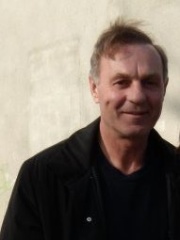
10. Guy Lafleur (1951 - 2022)
With an HPI of 47.85, Guy Lafleur is the 10th most famous Canadian Hockey Player. His biography has been translated into 23 different languages.
Guy Damien Lafleur (September 20, 1951 – April 22, 2022), nicknamed "the Flower" and "Le Démon Blond", was a Canadian professional ice hockey player. He was the first player in National Hockey League (NHL) history to score 50 goals in six consecutive seasons as well as 50 goals and 100 points in six consecutive seasons. Between 1971 and 1991, Lafleur played right wing for the Montreal Canadiens, New York Rangers, and Quebec Nordiques in an NHL career spanning 17 seasons, and five Stanley Cup championships in 1973, 1976, 1977, 1978, and 1979 (all with the Canadiens). Lafleur was inducted into the Hockey Hall of Fame in 1988, named one of the 100 Greatest NHL Players in history in 2017, and was named to the Order of Hockey in Canada in 2022.
People
Pantheon has 137 people classified as Canadian hockey players born between 1885 and 1997. Of these 137, 113 (82.48%) of them are still alive today. The most famous living Canadian hockey players include Wayne Gretzky, Phil Esposito, and Mario Lemieux. The most famous deceased Canadian hockey players include Maurice Richard, Gordie Howe, and Georges Vézina. As of April 2024, 28 new Canadian hockey players have been added to Pantheon including Ross Cuthbert, Frank Sullivan, and Colin Carruthers.
Living Canadian Hockey Players
Go to all RankingsWayne Gretzky
1961 - Present
HPI: 58.08
Phil Esposito
1942 - Present
HPI: 50.98
Mario Lemieux
1965 - Present
HPI: 50.40
Bobby Orr
1948 - Present
HPI: 49.89
Marcel Dionne
1951 - Present
HPI: 44.54
Mark Messier
1961 - Present
HPI: 42.89
Bobby Clarke
1949 - Present
HPI: 41.97
Steve Yzerman
1965 - Present
HPI: 40.35
Joe Sakic
1969 - Present
HPI: 40.15
Brett Hull
1964 - Present
HPI: 39.42
Martin Brodeur
1972 - Present
HPI: 39.37
Paul Coffey
1961 - Present
HPI: 38.81
Deceased Canadian Hockey Players
Go to all RankingsMaurice Richard
1921 - 2000
HPI: 57.38
Gordie Howe
1928 - 2016
HPI: 55.50
Georges Vézina
1887 - 1926
HPI: 52.73
Bobby Hull
1939 - 2023
HPI: 51.48
Henri Richard
1936 - 2020
HPI: 50.02
Guy Lafleur
1951 - 2022
HPI: 47.85
Howie Morenz
1902 - 1937
HPI: 44.22
Herb Drury
1896 - 1965
HPI: 43.79
Ross Cuthbert
1892 - 1971
HPI: 43.45
Ernie Collett
1895 - 1951
HPI: 43.00
Bernie Geoffrion
1931 - 2006
HPI: 42.87
Frank Sullivan
1898 - 1989
HPI: 40.95
Newly Added Canadian Hockey Players (2024)
Go to all RankingsRoss Cuthbert
1892 - 1971
HPI: 43.45
Frank Sullivan
1898 - 1989
HPI: 40.95
Colin Carruthers
1890 - 1957
HPI: 40.91
Sid Abel
1918 - 2000
HPI: 40.85
Eddie Shore
1902 - 1985
HPI: 39.10
Harry Sinden
1932 - Present
HPI: 37.52
Al Arbour
1932 - 2015
HPI: 37.41
Tiny Thompson
1903 - 1981
HPI: 37.26
Sean Burke
1967 - Present
HPI: 29.54
Curtis Joseph
1967 - Present
HPI: 28.12
Todd Bertuzzi
1975 - Present
HPI: 26.53
Kris Draper
1971 - Present
HPI: 25.42
Overlapping Lives
Which Hockey Players were alive at the same time? This visualization shows the lifespans of the 24 most globally memorable Hockey Players since 1700.

